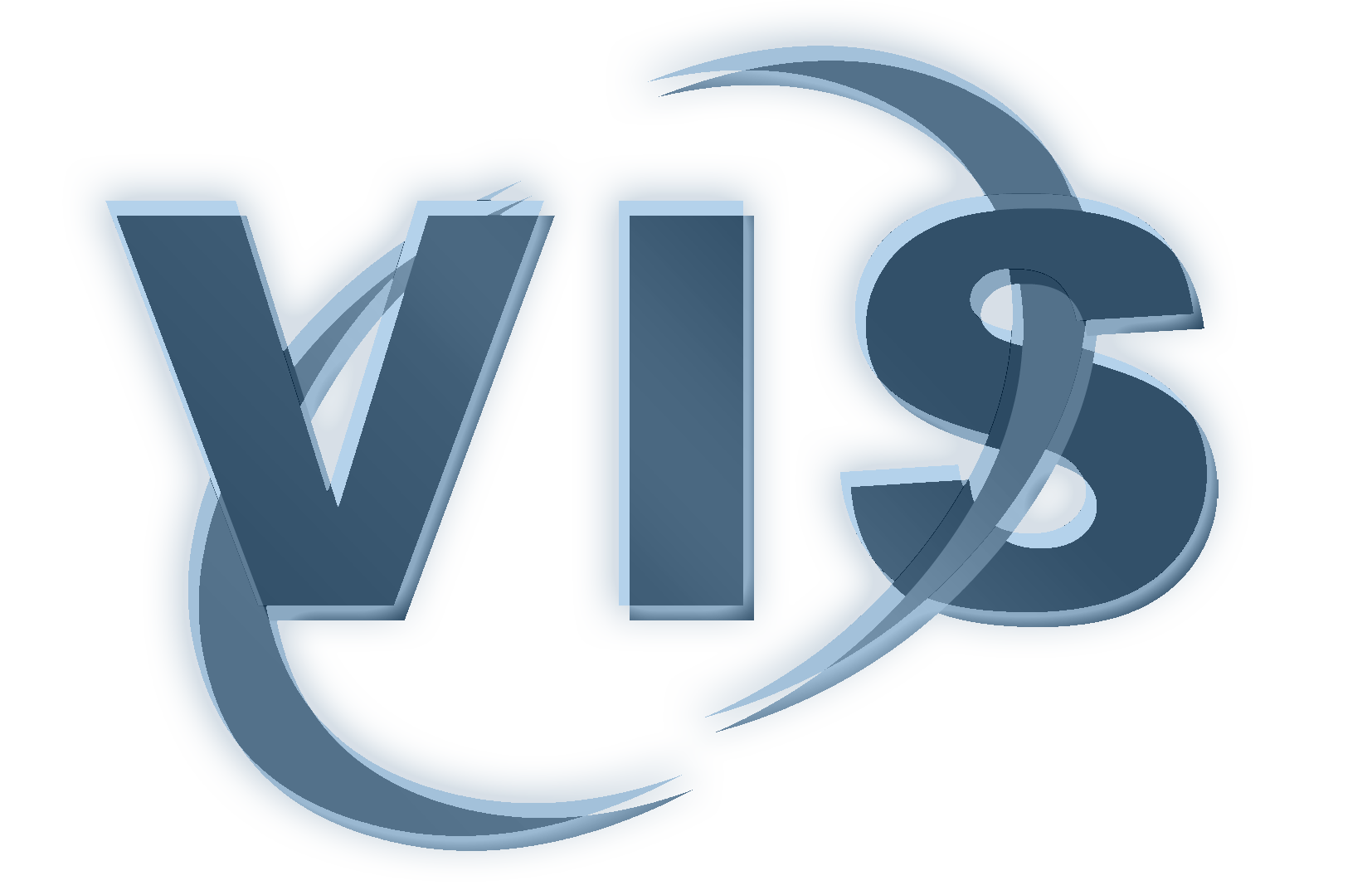2025 |
|
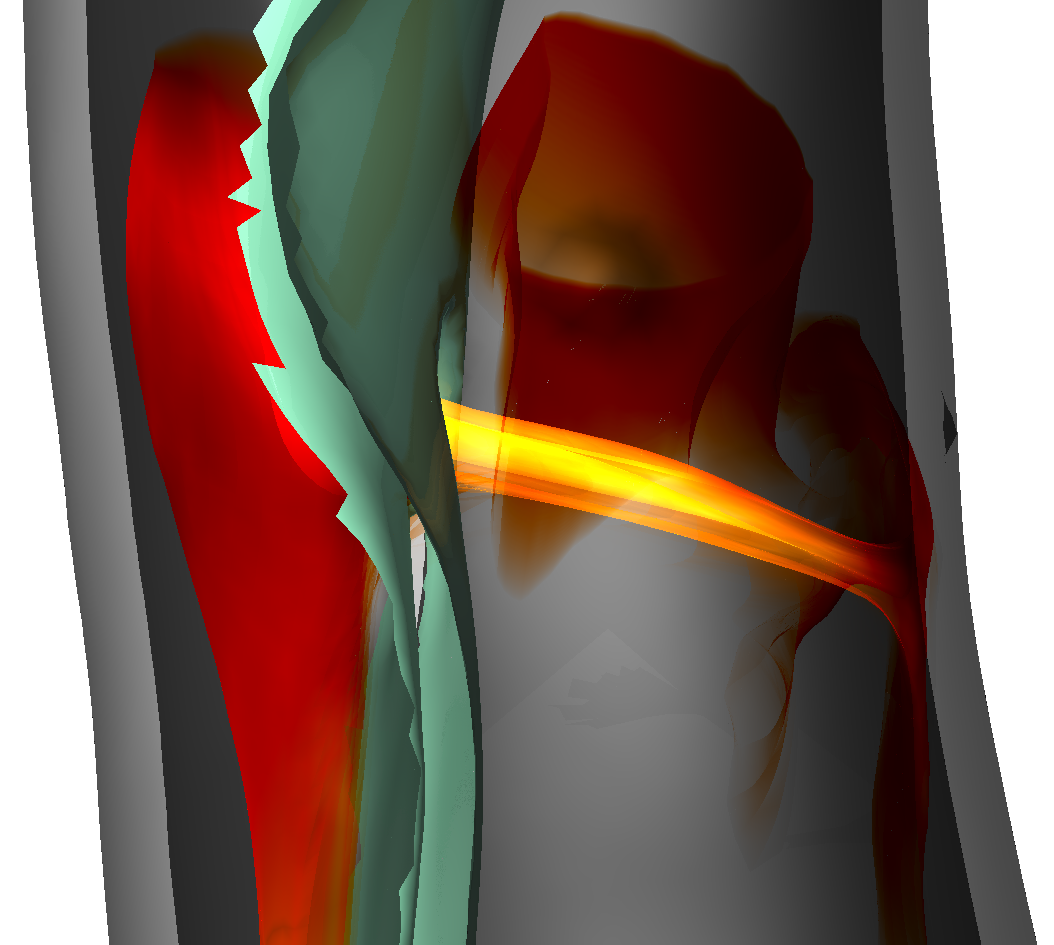 | Schroeder, Aaron, Ostendorf, Kai, Bäumler, Kathrin, Mastrodicasa, Domenico, Fleischmann, Dominik, Preim, Bernhard, Theisel, Holger, Mistelbauer, Gabriel Understanding Aortic Dissection Hemodynamics: Evaluating Adapted Smoke Surfaces Against Streakline-Based Techniques Journal Article Forthcoming IEEE Transactions on Visualization and Computer Graphics (Proc. IEEE VIS 2025), 33 (1), Forthcoming. @article{Schroeder2025, title = {Understanding Aortic Dissection Hemodynamics: Evaluating Adapted Smoke Surfaces Against Streakline-Based Techniques}, author = {Aaron Schroeder and Kai Ostendorf and Kathrin Bäumler and Domenico Mastrodicasa and Dominik Fleischmann and Bernhard Preim and Holger Theisel and Gabriel Mistelbauer}, url = {https://www.vismd.de/wp-content/uploads/2025/09/Schroeder2025.pdf https://www.vismd.de/wp-content/uploads/2025/09/Schroeder2025_plots.pdf https://www.vismd.de/wp-content/uploads/2025/09/Schroeder2025_results.xlsx}, year = {2025}, date = {2025-11-02}, journal = {IEEE Transactions on Visualization and Computer Graphics (Proc. IEEE VIS 2025)}, volume = {33}, number = {1}, publisher = {IEEE Transactions on Visualization and Computer Graphics (Proc. IEEE VIS 2025)}, abstract = {Aortic dissection is a life-threatening cardiovascular disease characterized by blood entering the media layer of the aortic vessel wall. This creates a second flow channel, known as the false lumen, which weakens the aortic wall and can potentially lead to fatal aortic rupture. Current risk stratification of aortic dissections is primarily based on morphological features of the aorta. However, hemodynamics also play a significant role in disease progression, though their investigation and visualization remain challenging. Common flow visualizations often experience visual clutter, especially when dealing with the intricate morphologies of aortic dissections. In this work, we implement and evaluate different approaches to visualizing the flow in aortic dissections effectively. We employ three techniques, namely streaklines with depth-dependent halos, transparent streaklines, and smoke surfaces. The latter is a technique based on streak surfaces, enhanced with opacity modulations, to produce a smoke-like appearance that improves visual clarity. We adapt the original opacity modulation of smoke surfaces to visualize flow even within the complex geometries of aortic dissections, thereby enhancing visual fidelity. To effectively capture dissection hemodynamics, we developed customized seeding structures that adapt to the shape of the surrounding lumen. Our evaluation, conducted via an online questionnaire, included medical professionals, fluid simulation experts, and visualization specialists. By analyzing results across these groups, we highlight differences in preference and interpretability, offering insight into domain-specific needs. No single visualization technique emerged as the best overall. Smoke surfaces provide the best overall clarity and visual realism. However, participants found streaklines with halos to be the best for quantifying flow, dispite them introducing significant visual clutter. Transparent streaklines serve as a middle ground, offering improved clarity over halos while maintaining some level of detail. Across all participant groups, smoke surfaces were rated as the most visually appealing and lifelike, with medical professionals highlighting their resemblance to contrast-agent injections used in clinical practice.}, keywords = {}, pubstate = {forthcoming}, tppubtype = {article} } Aortic dissection is a life-threatening cardiovascular disease characterized by blood entering the media layer of the aortic vessel wall. This creates a second flow channel, known as the false lumen, which weakens the aortic wall and can potentially lead to fatal aortic rupture. Current risk stratification of aortic dissections is primarily based on morphological features of the aorta. However, hemodynamics also play a significant role in disease progression, though their investigation and visualization remain challenging. Common flow visualizations often experience visual clutter, especially when dealing with the intricate morphologies of aortic dissections. In this work, we implement and evaluate different approaches to visualizing the flow in aortic dissections effectively. We employ three techniques, namely streaklines with depth-dependent halos, transparent streaklines, and smoke surfaces. The latter is a technique based on streak surfaces, enhanced with opacity modulations, to produce a smoke-like appearance that improves visual clarity. We adapt the original opacity modulation of smoke surfaces to visualize flow even within the complex geometries of aortic dissections, thereby enhancing visual fidelity. To effectively capture dissection hemodynamics, we developed customized seeding structures that adapt to the shape of the surrounding lumen. Our evaluation, conducted via an online questionnaire, included medical professionals, fluid simulation experts, and visualization specialists. By analyzing results across these groups, we highlight differences in preference and interpretability, offering insight into domain-specific needs. No single visualization technique emerged as the best overall. Smoke surfaces provide the best overall clarity and visual realism. However, participants found streaklines with halos to be the best for quantifying flow, dispite them introducing significant visual clutter. Transparent streaklines serve as a middle ground, offering improved clarity over halos while maintaining some level of detail. Across all participant groups, smoke surfaces were rated as the most visually appealing and lifelike, with medical professionals highlighting their resemblance to contrast-agent injections used in clinical practice. |
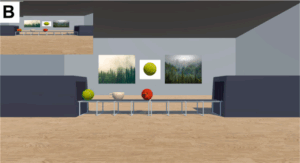 | Belger, Julia, Peters, Lisa Patricia, Jakober, Jorik, Wagner, Sebastian, Preim, Bernhard, Villringer, Arno, Thoene-Otto, Angelika Virtual reality eye movement training for neglect rehabilitation Journal Article International Journal of Clinical and Health Psychology, 25 (4), 2025. @article{Belger2025, title = {Virtual reality eye movement training for neglect rehabilitation}, author = {Julia Belger and Lisa Patricia Peters and Jorik Jakober and Sebastian Wagner and Bernhard Preim and Arno Villringer and Angelika Thoene-Otto}, doi = {https://doi.org/10.1016/j.ijchp.2025.100630}, year = {2025}, date = {2025-10-15}, journal = {International Journal of Clinical and Health Psychology}, volume = {25}, number = {4}, abstract = {Background Smooth pursuit training (SPT) is recognized as an effective intervention for spatial neglect by guiding patients’ attention toward the contralesional hemifield through repetitive tracking of moving visual stimuli. However, traditional SPT approaches lack standardized, real-time feedback on gaze and head position and patient motivation, limiting therapists' ability to monitor attention and patients' engagement effectively. Combining immersive virtual reality (VR) with eye tracking may overcome these limitations by providing immediate automated feedback, enhancing therapeutic outcomes and being associated with increased awareness of deficits. Methods We developed and evaluated an immersive Virtual Reality Eye Movement Training (VR-EMT) paradigm integrating eye tracking and real-time automated feedback on gaze and head orientation. Twelve chronic post-stroke patients with left-sided neglect completed 10 VR-EMT sessions (each lasting 18 min). We assessed performance in a spatially lateralized object transport task, head rotation behavior, gaze distribution, usability, and patient preferences in comparison to traditional SPT. Results VR-EMT was independently executable and highly accepted by patients. Real-time feedback improved patients' head orientation awareness and adjustments. Task accuracy decreased with increasing task difficulty, indicating effective demand modulation. A persistent ipsilesional gaze bias was found during breaks. Patients preferred VR-EMT over traditional SPT due to enhanced feedback, motivation, and challenge. Cybersickness was minimal and did not impair performance. Conclusions This feasibility study demonstrated that VR-EMT integrating eye tracking and immediate feedback is technically feasible, clinically applicable, well-accepted, and subjectively preferred over traditional methods in chronic post-stroke neglect patients. Eye tracking functioned reliably, even as the sole interaction modality. Real-time feedback facilitated rapid behavioral adjustments, highlighting the potential for individualized interventions and remote application. Future studies should evaluate clinical efficacy and the benefits of eye-tracking-based attentional assessment.}, keywords = {}, pubstate = {published}, tppubtype = {article} } Background Smooth pursuit training (SPT) is recognized as an effective intervention for spatial neglect by guiding patients’ attention toward the contralesional hemifield through repetitive tracking of moving visual stimuli. However, traditional SPT approaches lack standardized, real-time feedback on gaze and head position and patient motivation, limiting therapists' ability to monitor attention and patients' engagement effectively. Combining immersive virtual reality (VR) with eye tracking may overcome these limitations by providing immediate automated feedback, enhancing therapeutic outcomes and being associated with increased awareness of deficits. Methods We developed and evaluated an immersive Virtual Reality Eye Movement Training (VR-EMT) paradigm integrating eye tracking and real-time automated feedback on gaze and head orientation. Twelve chronic post-stroke patients with left-sided neglect completed 10 VR-EMT sessions (each lasting 18 min). We assessed performance in a spatially lateralized object transport task, head rotation behavior, gaze distribution, usability, and patient preferences in comparison to traditional SPT. Results VR-EMT was independently executable and highly accepted by patients. Real-time feedback improved patients' head orientation awareness and adjustments. Task accuracy decreased with increasing task difficulty, indicating effective demand modulation. A persistent ipsilesional gaze bias was found during breaks. Patients preferred VR-EMT over traditional SPT due to enhanced feedback, motivation, and challenge. Cybersickness was minimal and did not impair performance. Conclusions This feasibility study demonstrated that VR-EMT integrating eye tracking and immediate feedback is technically feasible, clinically applicable, well-accepted, and subjectively preferred over traditional methods in chronic post-stroke neglect patients. Eye tracking functioned reliably, even as the sole interaction modality. Real-time feedback facilitated rapid behavioral adjustments, highlighting the potential for individualized interventions and remote application. Future studies should evaluate clinical efficacy and the benefits of eye-tracking-based attentional assessment. |
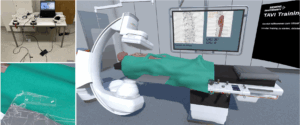 | Jakober, Jorik, Kunz, Matthias, Kreher, Robert, Pantano, Matteo, Braß, Daniel, Weidling, Janine, Hansen, Christian, Braun-Dullaeus, Rüdiger, Preim, Bernhard Design, development, and evaluation of an immersive augmented virtuality training system for transcatheter aortic valve replacement Journal Article Computers & Graphics, 133 , 2025. @article{Jakober2025b, title = {Design, development, and evaluation of an immersive augmented virtuality training system for transcatheter aortic valve replacement}, author = {Jorik Jakober and Matthias Kunz and Robert Kreher and Matteo Pantano and Daniel Braß and Janine Weidling and Christian Hansen and Rüdiger Braun-Dullaeus and Bernhard Preim}, doi = {https://doi.org/10.1016/j.cag.2025.104414}, year = {2025}, date = {2025-09-12}, journal = {Computers & Graphics}, volume = {133}, abstract = {Strong procedural skills are essential to perform safe and effective transcatheter aortic valve replacement (TAVR). Traditional training takes place in the operating room (OR) on real patients and requires learning new motor skills, resulting in longer procedure times, increased risk of complications, and greater radiation exposure for patients and medical personnel. Desktop-based simulators in interventional cardiology have shown some validity but lack true depth perception, whereas head-mounted display based Virtual Reality (VR) offers intuitive 3D interaction that enhances training effectiveness and spatial understanding. However, providing realistic and immersive training remains a challenging task as both lack tactile feedback. We have developed an augmented virtuality (AV) training system for transfemoral TAVR, combining a catheter tracking device (for translational input) with a simulated virtual OR. The system enables users to manually control a virtual angiography system via hand tracking and navigate a guidewire through a virtual patient up to the aortic valve using fluoroscopic-like imaging. In addition, we conducted a preliminary user study with 12 participants, assessing cybersickness, usability, workload, sense of presence, and qualitative factors. Preliminary results indicate that the system provides realistic interaction for key procedural steps, making it a suitable learning tool for novices. Limitations in angiography system operation include the lack of haptic resistance and usability limitations related to C-arm control, particularly due to hand tracking constraints and split attention between interaction and monitoring. Suggestions for improvement include catheter rotation tracking, expanded procedural coverage, and enhanced fluoroscopic image fidelity.}, keywords = {}, pubstate = {published}, tppubtype = {article} } Strong procedural skills are essential to perform safe and effective transcatheter aortic valve replacement (TAVR). Traditional training takes place in the operating room (OR) on real patients and requires learning new motor skills, resulting in longer procedure times, increased risk of complications, and greater radiation exposure for patients and medical personnel. Desktop-based simulators in interventional cardiology have shown some validity but lack true depth perception, whereas head-mounted display based Virtual Reality (VR) offers intuitive 3D interaction that enhances training effectiveness and spatial understanding. However, providing realistic and immersive training remains a challenging task as both lack tactile feedback. We have developed an augmented virtuality (AV) training system for transfemoral TAVR, combining a catheter tracking device (for translational input) with a simulated virtual OR. The system enables users to manually control a virtual angiography system via hand tracking and navigate a guidewire through a virtual patient up to the aortic valve using fluoroscopic-like imaging. In addition, we conducted a preliminary user study with 12 participants, assessing cybersickness, usability, workload, sense of presence, and qualitative factors. Preliminary results indicate that the system provides realistic interaction for key procedural steps, making it a suitable learning tool for novices. Limitations in angiography system operation include the lack of haptic resistance and usability limitations related to C-arm control, particularly due to hand tracking constraints and split attention between interaction and monitoring. Suggestions for improvement include catheter rotation tracking, expanded procedural coverage, and enhanced fluoroscopic image fidelity. |
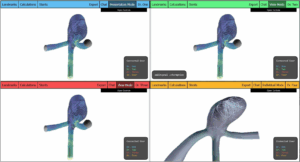 | Preßler, Rebecca, Meuschke, Monique, Preim, Bernhard, Lawonn, Kai Visualization Support for Remote Collaborative Aneurysm Treatment Planning Journal Article International Journal of Computer Assisted Radiology and Surgery, 2025. @article{Preßler2025, title = {Visualization Support for Remote Collaborative Aneurysm Treatment Planning}, author = {Rebecca Preßler and Monique Meuschke and Bernhard Preim and Kai Lawonn}, year = {2025}, date = {2025-08-18}, journal = {International Journal of Computer Assisted Radiology and Surgery}, keywords = {}, pubstate = {published}, tppubtype = {article} } |
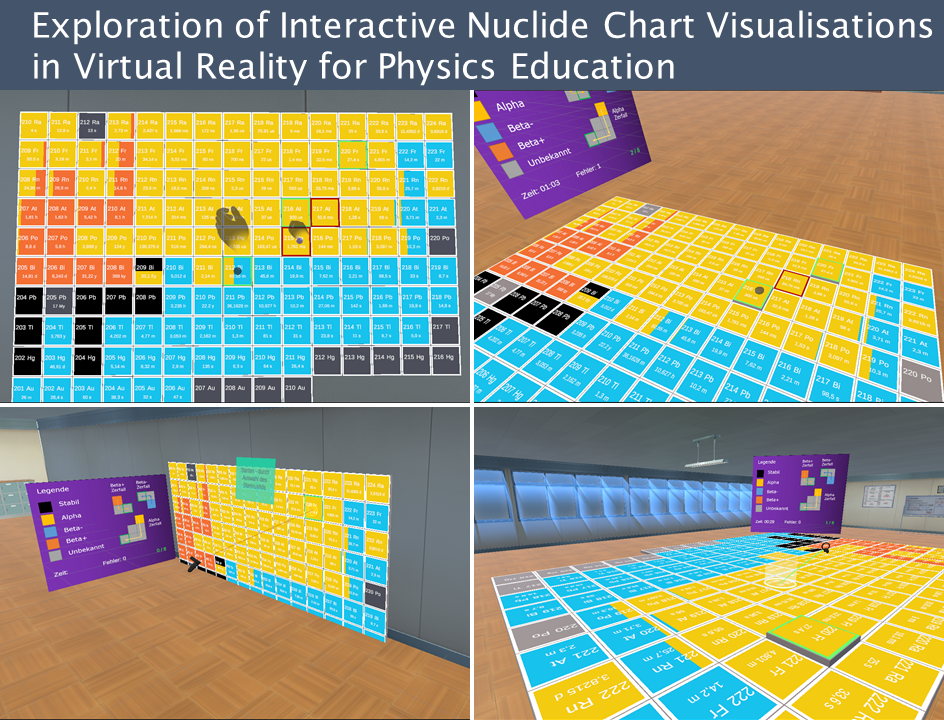 | Zöllner, Janine, Preim, Bernhard, Vahlbruch, Jan-Willem, Pottgießer, Vivien, Saalfeld, Patrick Exploration of interactive nuclide chart visualisations in virtual reality for physics education Journal Article Computers & Graphics, 130 (104258), 2025. @article{Zoellner25, title = {Exploration of interactive nuclide chart visualisations in virtual reality for physics education}, author = {Janine Zöllner and Bernhard Preim and Jan-Willem Vahlbruch and Vivien Pottgießer and Patrick Saalfeld}, doi = {https://doi.org/10.1016/j.cag.2025.104258}, year = {2025}, date = {2025-08-01}, journal = {Computers & Graphics}, volume = {130}, number = {104258}, abstract = {Immersive virtual reality (VR) is used for various types of learning content. One fundamental but challenging part of VR applications are suitable interaction techniques. In this work, we use the example of interactive nuclide charts to investigate interaction techniques in VR. For this purpose, four variants of visualising an interactive nuclide chart for decay rows in a VR environment were implemented: The floor-freehand variant offers the possibility to move freely on the chart, the floor-controller variant enables teleportation to nuclides using the controller, the wall-freehand variant uses hand gestures to select nuclides, and the wall-controller variant also uses the controller to select nuclides on the wall. Our user study with 24 participants indicated that the wall-controller variant was favoured in terms of usability and user experience.}, keywords = {}, pubstate = {published}, tppubtype = {article} } Immersive virtual reality (VR) is used for various types of learning content. One fundamental but challenging part of VR applications are suitable interaction techniques. In this work, we use the example of interactive nuclide charts to investigate interaction techniques in VR. For this purpose, four variants of visualising an interactive nuclide chart for decay rows in a VR environment were implemented: The floor-freehand variant offers the possibility to move freely on the chart, the floor-controller variant enables teleportation to nuclides using the controller, the wall-freehand variant uses hand gestures to select nuclides, and the wall-controller variant also uses the controller to select nuclides on the wall. Our user study with 24 participants indicated that the wall-controller variant was favoured in terms of usability and user experience. |
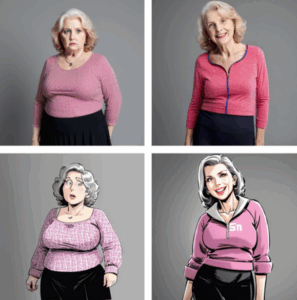 | Mittenentzwei, Sarah, Garrison, Laura A, Budich, Beatrice, Lawonn, Kai, Dockhorn, Alexander, Preim, Bernhard, Meuschke, Monique AI-based character generation for disease stories: a case study using epidemiological data to highlight preventable risk factors Journal Article i-com, 24 (1), pp. 259-281, 2025. @article{Mittenentzwei2025, title = {AI-based character generation for disease stories: a case study using epidemiological data to highlight preventable risk factors}, author = {Sarah Mittenentzwei and Laura A Garrison and Beatrice Budich and Kai Lawonn and Alexander Dockhorn and Bernhard Preim and Monique Meuschke}, url = {https://vis.uib.no/wp-content/papercite-data/pdfs/mittenentzwei2025icom.pdf}, doi = {https://doi.org/10.1515/icom-2024-0041}, year = {2025}, date = {2025-04-16}, journal = {i-com}, volume = {24}, number = {1}, pages = {259-281}, abstract = {Data-driven storytelling has grown significantly, becoming prevalent in various fields, including healthcare. In medical narratives, characters are crucial for engaging audiences, making complex medical information accessible, and potentially influencing positive behavioral and lifestyle changes. However, designing characters that are both educational and relatable to effectively engage audiences is challenging. We propose a GenAI-assisted pipeline for character design in data-driven medical stories, utilizing Stable Diffusion, a deep learning text-to-image model, to transform data into visual character representations. This approach reduces the time and artistic skills required to create characters that reflect the underlying data. As a proof-of-concept, we generated and evaluated two characters in a crowd-sourced case study, assessing their authenticity to the underlying data and consistency over time. In a qualitative evaluation with four experts with knowledge in design and health communication, the characters were discussed regarding their quality and refinement opportunities. The characters effectively conveyed various aspects of the data, such as emotions, age, and body weight. However, generating multiple consistent images of the same character proved to be a significant challenge. This underscores a key issue in using generative AI for character creation: the limited control designers have over the output.}, keywords = {}, pubstate = {published}, tppubtype = {article} } Data-driven storytelling has grown significantly, becoming prevalent in various fields, including healthcare. In medical narratives, characters are crucial for engaging audiences, making complex medical information accessible, and potentially influencing positive behavioral and lifestyle changes. However, designing characters that are both educational and relatable to effectively engage audiences is challenging. We propose a GenAI-assisted pipeline for character design in data-driven medical stories, utilizing Stable Diffusion, a deep learning text-to-image model, to transform data into visual character representations. This approach reduces the time and artistic skills required to create characters that reflect the underlying data. As a proof-of-concept, we generated and evaluated two characters in a crowd-sourced case study, assessing their authenticity to the underlying data and consistency over time. In a qualitative evaluation with four experts with knowledge in design and health communication, the characters were discussed regarding their quality and refinement opportunities. The characters effectively conveyed various aspects of the data, such as emotions, age, and body weight. However, generating multiple consistent images of the same character proved to be a significant challenge. This underscores a key issue in using generative AI for character creation: the limited control designers have over the output. |
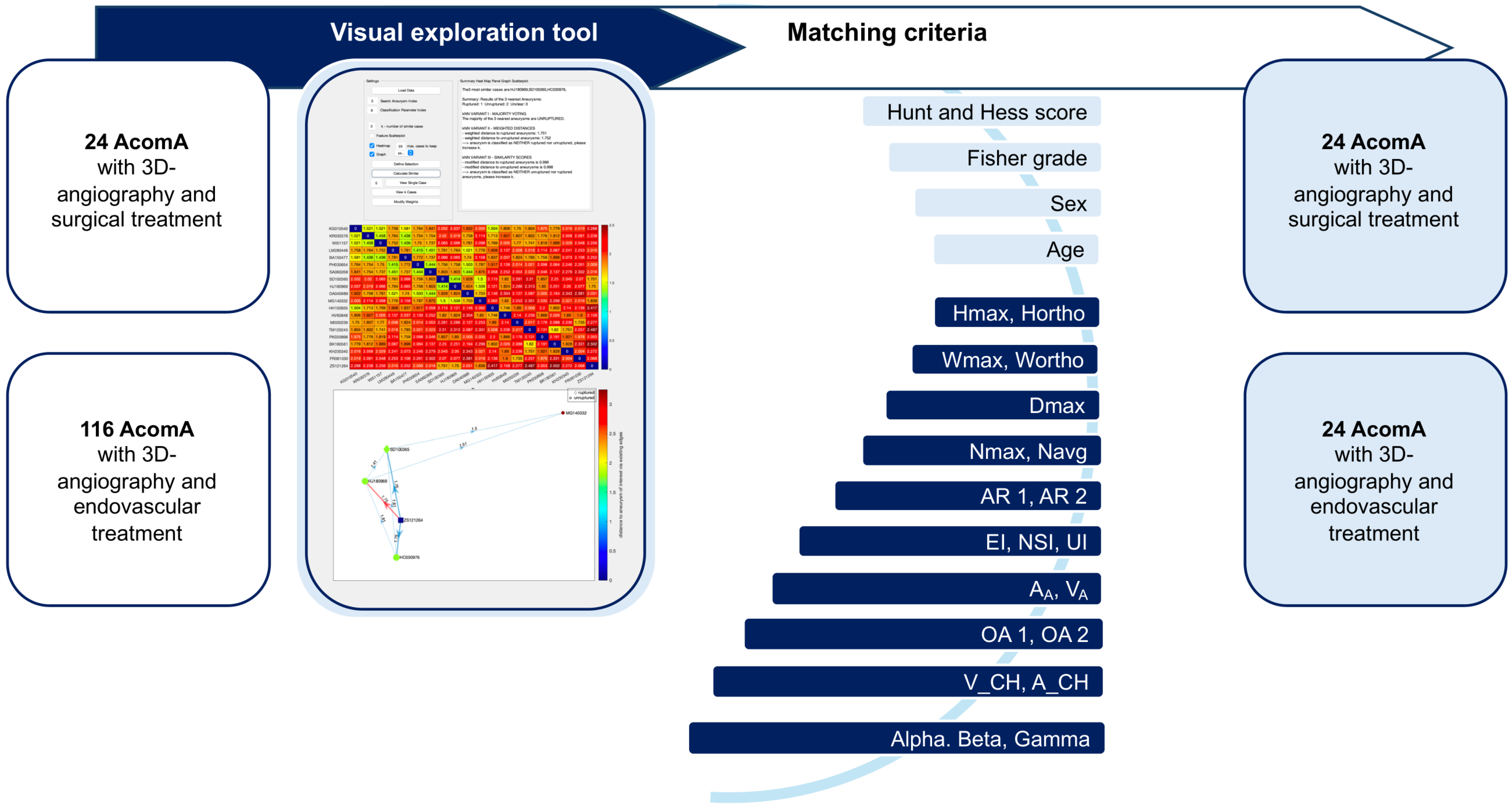 | Swiatek, Vanessa M, Amini, Amir, Dumitru, Claudia A., Spitz, Lena Iam, Stein, Klaus-Peter, Saalfeld, Sylvia, Rashidi, Ali, Sandalcioglu, I. Erol, Neyazi, Belal Multidimensional Comparison of Microsurgical Clipping and Endovascular Techniques for Anterior Communicating Artery Aneurysms: Balancing Occlusion Rates and Periprocedural Risks Journal Article medicina, 61 (3), pp. 498, 2025. BibTeX | Links: @article{Swiatek_2025_multidimensialClipCoil, title = {Multidimensional Comparison of Microsurgical Clipping and Endovascular Techniques for Anterior Communicating Artery Aneurysms: Balancing Occlusion Rates and Periprocedural Risks}, author = {Vanessa M Swiatek and Amir Amini and Claudia A. Dumitru and Lena Iam Spitz and Klaus-Peter Stein and Sylvia Saalfeld and Ali Rashidi and I. Erol Sandalcioglu and Belal Neyazi}, doi = {https://doi.org/10.3390/medicina61030498}, year = {2025}, date = {2025-03-13}, journal = {medicina}, volume = {61}, number = {3}, pages = {498}, keywords = {}, pubstate = {published}, tppubtype = {article} } |
Allgaier, Mareen, Dangszat, Eric-Morten, Huettl, Florentine, Hanke, Laura Isabel, Huber, Tobias, Preim, Bernhard, Hansen, Christian Impact of Input and Output Devices on a Virtual Ultrasound Training Journal Article 2025 IEEE Conference on Virtual Reality and 3D User Interfaces Abstracts and Workshops (VRW), pp. 937-941, 2025. @article{Allgeier2025, title = {Impact of Input and Output Devices on a Virtual Ultrasound Training}, author = {Mareen Allgaier and Eric-Morten Dangszat and Florentine Huettl and Laura Isabel Hanke and Tobias Huber and Bernhard Preim and Christian Hansen}, doi = {10.1109/VRW66409.2025.00191}, year = {2025}, date = {2025-03-08}, journal = {2025 IEEE Conference on Virtual Reality and 3D User Interfaces Abstracts and Workshops (VRW)}, pages = {937-941}, abstract = {Performing ultrasound requires mental skills that have to be trained hands on. Virtual simulations can be employed to provide novice surgeons with a safe training environment prior to performing ultrasound on the patient. For both input and output there is a wide range of devices that are used in existing ultrasound simulations. Because the devices have their limitations and benefits regarding realism, costs, and access, we compared three technical setups: desktop with mouse interaction, desktop with a haptic device, and virtual reality with a haptic device. In a user study with 19 participants we investigated the usability and assessed qualitative user feedback in a semi-structured interview. Significant differences regarding usability and training time were found between both versions with the haptic device and the desktop with mouse version. Based on the feedback, using a haptic device seems to be more relevant than the two output devices in this training case.}, keywords = {}, pubstate = {published}, tppubtype = {article} } Performing ultrasound requires mental skills that have to be trained hands on. Virtual simulations can be employed to provide novice surgeons with a safe training environment prior to performing ultrasound on the patient. For both input and output there is a wide range of devices that are used in existing ultrasound simulations. Because the devices have their limitations and benefits regarding realism, costs, and access, we compared three technical setups: desktop with mouse interaction, desktop with a haptic device, and virtual reality with a haptic device. In a user study with 19 participants we investigated the usability and assessed qualitative user feedback in a semi-structured interview. Significant differences regarding usability and training time were found between both versions with the haptic device and the desktop with mouse version. Based on the feedback, using a haptic device seems to be more relevant than the two output devices in this training case. | |
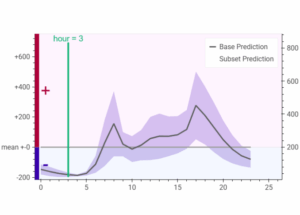 | Kleinau, Anna, Preim, Bernhard, Meuschke, Monique FINCH: Locally Visualizing Higher-Order Feature Interactions in Black Box Models Journal Article arXiv, 2025. @article{Kleinau2025, title = {FINCH: Locally Visualizing Higher-Order Feature Interactions in Black Box Models}, author = {Anna Kleinau and Bernhard Preim and Monique Meuschke}, doi = { https://doi.org/10.48550/arXiv.2503.16445}, year = {2025}, date = {2025-02-17}, journal = {arXiv}, abstract = {In an era where black-box AI models are integral to decision-making across industries, robust methods for explaining these models are more critical than ever. While these models leverage complex feature interplay for accurate predictions, most explanation methods only assign relevance to individual features. There is a research gap in methods that effectively illustrate interactions between features, especially in visualizing higher-order interactions involving multiple features, which challenge conventional representation methods. To address this challenge in local explanations focused on individual instances, we employ a visual, subset-based approach to reveal relevant feature interactions. Our visual analytics tool FINCH uses coloring and highlighting techniques to create intuitive, human-centered visualizations, and provides additional views that enable users to calibrate their trust in the model and explanations. We demonstrate FINCH in multiple case studies, demonstrating its generalizability, and conducted an extensive human study with machine learning experts to highlight its helpfulness and usability. With this approach, FINCH allows users to visualize feature interactions involving any number of features locally.}, keywords = {}, pubstate = {published}, tppubtype = {article} } In an era where black-box AI models are integral to decision-making across industries, robust methods for explaining these models are more critical than ever. While these models leverage complex feature interplay for accurate predictions, most explanation methods only assign relevance to individual features. There is a research gap in methods that effectively illustrate interactions between features, especially in visualizing higher-order interactions involving multiple features, which challenge conventional representation methods. To address this challenge in local explanations focused on individual instances, we employ a visual, subset-based approach to reveal relevant feature interactions. Our visual analytics tool FINCH uses coloring and highlighting techniques to create intuitive, human-centered visualizations, and provides additional views that enable users to calibrate their trust in the model and explanations. We demonstrate FINCH in multiple case studies, demonstrating its generalizability, and conducted an extensive human study with machine learning experts to highlight its helpfulness and usability. With this approach, FINCH allows users to visualize feature interactions involving any number of features locally. |
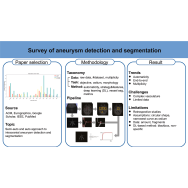 | Hsu, Wei-Chan, Meuschke, Monique, Frangi, Alejandro F., Preim, Bernhard, Lawonn, Kai A survey of intracranial aneurysm detection and segmentation Journal Article Medical Image Analysis, 101 , 2025. BibTeX | Links: @article{Hsu_MIA, title = {A survey of intracranial aneurysm detection and segmentation}, author = {Wei-Chan Hsu and Monique Meuschke and Alejandro F. Frangi and Bernhard Preim and Kai Lawonn}, editor = {Elsevier}, doi = {https://doi.org/10.1016/j.media.2025.103493}, year = {2025}, date = {2025-02-11}, journal = {Medical Image Analysis}, volume = {101}, keywords = {}, pubstate = {published}, tppubtype = {article} } |
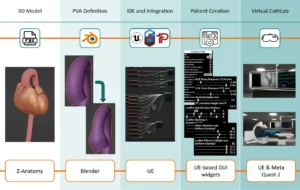 | Razavizadeh, Seyedsina, Kofler, Markus, Kunz, Matthias, Kempfert, Joerg, Braun-Dullaeus, Ruediger, Weidling, Janine, Preim, Bernhard, Hansen, Christian A virtual patient authoring tool for transcatheter aortic valve replacement Journal Article International Journal of Computer Assisted Radiology and Surgery, 20 (2), pp. 379-389, 2025. @article{Razavizadeh2025, title = {A virtual patient authoring tool for transcatheter aortic valve replacement}, author = {Seyedsina Razavizadeh and Markus Kofler and Matthias Kunz and Joerg Kempfert and Ruediger Braun-Dullaeus and Janine Weidling and Bernhard Preim and Christian Hansen}, doi = {https://doi.org/10.1007/s11548-024-03293-x}, year = {2025}, date = {2025-02-01}, journal = {International Journal of Computer Assisted Radiology and Surgery}, volume = {20}, number = {2}, pages = {379-389}, abstract = {Purpose Computer-based medical training scenarios, derived from patient’s records, often lack variability, modifiability, and availability. Furthermore, generating image datasets and creating scenarios is resource-intensive. Therefore, patient authoring tools for rapid dataset-independent creation of virtual patients (VPs) is a pressing need. Methods An authoring tool and a virtual catheterization laboratory environment were developed. The tool allows customised VP generation through a real-time morphable heart model and Euroscore parameters. The generated VP can be examined inside the vCathLab using a fluoroscopy and monitoring device, both on desktop and immersive virtual reality. Seven board-certified experts evaluated the proposed method from three aspects, i.e. System Usability Scale, qualitative feedback, and its performance in VR. Results All participants agreed that this method could provide the necessary information and is anatomically correct within an educational context. Its modifiability, variability, and simplicity were well recognised. The prototype achieved excellent usability score and considerable performance results. Conclusion We present a highly variable VP authoring tool that enhances variability in medical training scenarios. Although this work does not aim to explore didactic aspects, the potential of using this approach in an educational context has been confirmed in our study. Accordingly, these aspects can benefit from a thorough investigation in the future. In addition, our tool can be improved to provide more realistic parameter ranges for procedure-specific cases.}, keywords = {}, pubstate = {published}, tppubtype = {article} } Purpose Computer-based medical training scenarios, derived from patient’s records, often lack variability, modifiability, and availability. Furthermore, generating image datasets and creating scenarios is resource-intensive. Therefore, patient authoring tools for rapid dataset-independent creation of virtual patients (VPs) is a pressing need. Methods An authoring tool and a virtual catheterization laboratory environment were developed. The tool allows customised VP generation through a real-time morphable heart model and Euroscore parameters. The generated VP can be examined inside the vCathLab using a fluoroscopy and monitoring device, both on desktop and immersive virtual reality. Seven board-certified experts evaluated the proposed method from three aspects, i.e. System Usability Scale, qualitative feedback, and its performance in VR. Results All participants agreed that this method could provide the necessary information and is anatomically correct within an educational context. Its modifiability, variability, and simplicity were well recognised. The prototype achieved excellent usability score and considerable performance results. Conclusion We present a highly variable VP authoring tool that enhances variability in medical training scenarios. Although this work does not aim to explore didactic aspects, the potential of using this approach in an educational context has been confirmed in our study. Accordingly, these aspects can benefit from a thorough investigation in the future. In addition, our tool can be improved to provide more realistic parameter ranges for procedure-specific cases. |
 | Kreher, Robert, Hille, Georg, Preim, Bernhard, Hinnerichs, Mattes, Borggrefe, Jan, Surov, Alexey, Saalfeld, Sylvia Multilabel segmentation and analysis of skeletal muscle and adipose tissue in routine abdominal CT scans Journal Article Computers in Biology and Medicine, 186 , 2025. @article{Kehrer2025, title = {Multilabel segmentation and analysis of skeletal muscle and adipose tissue in routine abdominal CT scans}, author = {Robert Kreher and Georg Hille and Bernhard Preim and Mattes Hinnerichs and Jan Borggrefe and Alexey Surov and Sylvia Saalfeld }, doi = {https://doi.org/10.1016/j.compbiomed.2024.109622}, year = {2025}, date = {2025-01-07}, journal = {Computers in Biology and Medicine}, volume = {186}, abstract = {Purpose: This paper presents a deep learning-based multi-label segmentation network that extracts a total of three separate adipose tissues and five different muscle tissues in CT slices of the third lumbar vertebra and additionally improves the segmentation of the intermuscular fat. Method: Based on a self-created data set of 130 patients, an extended Unet structure was trained and evaluated with the help of Dice score, IoU and Pixel Accuracy. In addition, the interobserver variability for the decision between ground truth and post-processed segmentation was calculated to illustrate the relevance in everyday clinical practice. Results: On average, the presented approach achieved 91.0 ± 0.065% DSC for the muscle tissues and 88.9 ± 0.062% DSC for the adipose tissues. It was shown that by post-processing the intermuscular fat tissue, physicians prefer the result of the algorithm presented in the paper to their segmentation by 91.51%. Conclusion: The algorithm provided more precise segmentations of muscles and adipose tissue, demonstrating high-quality performance in segmenting muscle tissue. In qualitative evaluations, physicians preferred the algorithm’s segmentation over expert segmentations, with the preference quantified as 91.51%. This indicates that, based on their assessment, the algorithm’s results were significantly favored. This qualitative feedback supports the algorithm’s use in subsequent analyses of patient fitness, leveraging the detailed information it provides.}, keywords = {}, pubstate = {published}, tppubtype = {article} } Purpose: This paper presents a deep learning-based multi-label segmentation network that extracts a total of three separate adipose tissues and five different muscle tissues in CT slices of the third lumbar vertebra and additionally improves the segmentation of the intermuscular fat. Method: Based on a self-created data set of 130 patients, an extended Unet structure was trained and evaluated with the help of Dice score, IoU and Pixel Accuracy. In addition, the interobserver variability for the decision between ground truth and post-processed segmentation was calculated to illustrate the relevance in everyday clinical practice. Results: On average, the presented approach achieved 91.0 ± 0.065% DSC for the muscle tissues and 88.9 ± 0.062% DSC for the adipose tissues. It was shown that by post-processing the intermuscular fat tissue, physicians prefer the result of the algorithm presented in the paper to their segmentation by 91.51%. Conclusion: The algorithm provided more precise segmentations of muscles and adipose tissue, demonstrating high-quality performance in segmenting muscle tissue. In qualitative evaluations, physicians preferred the algorithm’s segmentation over expert segmentations, with the preference quantified as 91.51%. This indicates that, based on their assessment, the algorithm’s results were significantly favored. This qualitative feedback supports the algorithm’s use in subsequent analyses of patient fitness, leveraging the detailed information it provides. |
 | Poehls, Jeran, Meuschke, Monique, Carvalhais, Nunu, Lawonn, Kai Either Or: Interactive Articles or Videos for Climate Science Communication Journal Article COMPUTER GRAPHICS forum, 44 (3), 2025. @article{Poehls2025, title = {Either Or: Interactive Articles or Videos for Climate Science Communication}, author = {Jeran Poehls and Monique Meuschke and Nunu Carvalhais and Kai Lawonn}, url = {https://vis.uni-jena.de/wp-content/uploads/2025/files/InteractiveArticlesorVideos.pdf}, year = {2025}, date = {2025-01-01}, journal = {COMPUTER GRAPHICS forum}, volume = {44}, number = {3}, abstract = {Effective communication of climate science is critical as climate-related disasters become more frequent and severe. Translating complex information, such as uncertainties in climate model predictions, into formats accessible to diverse audiences is key to informed decision-making and public engagement. This study investigates how different teaching formats can enhance understanding of these uncertainties. This study compares two multimodal strategies: (1) a text-image format with interactive components and (2) an explainer video combining dynamic visuals with narration. Participants’ immediate and delayed retention (one week) and engagement are assessed to determine which format offers greater saliency. Sample analysis (n = 622) displayed equivalent retention by viewers between both formats. Metrics assessing interactivity found no correlation between interactivity and information retention. However, a stark contrast was observed in the time viewers spent engaging with each format. The video format was 29% more efficient with information taught over a period of time vs. the article. Additionally, retention on the video format worsened with age (P = 0.004) while retention on the article format improved with education (P = 0.038). These results align with previous findings in literature.}, keywords = {}, pubstate = {published}, tppubtype = {article} } Effective communication of climate science is critical as climate-related disasters become more frequent and severe. Translating complex information, such as uncertainties in climate model predictions, into formats accessible to diverse audiences is key to informed decision-making and public engagement. This study investigates how different teaching formats can enhance understanding of these uncertainties. This study compares two multimodal strategies: (1) a text-image format with interactive components and (2) an explainer video combining dynamic visuals with narration. Participants’ immediate and delayed retention (one week) and engagement are assessed to determine which format offers greater saliency. Sample analysis (n = 622) displayed equivalent retention by viewers between both formats. Metrics assessing interactivity found no correlation between interactivity and information retention. However, a stark contrast was observed in the time viewers spent engaging with each format. The video format was 29% more efficient with information taught over a period of time vs. the article. Additionally, retention on the video format worsened with age (P = 0.004) while retention on the article format improved with education (P = 0.038). These results align with previous findings in literature. |
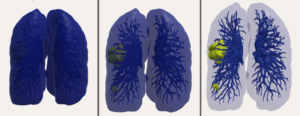 | Mlitzke, Sophie, Mittenentzwei, Sarah, Preim, Bernhard, Meuschke, Monique Interaction in Narrative Medical Visualization: Insights from a Case Study on Tumor Diseases Inproceedings Proc. of Eurographics Workshop on Visual Computing for Biology and Medicine, 2025. BibTeX | Links: @inproceedings{Mlitzke2025VCBM, title = {Interaction in Narrative Medical Visualization: Insights from a Case Study on Tumor Diseases}, author = {Sophie Mlitzke and Sarah Mittenentzwei and Bernhard Preim and Monique Meuschke}, url = {https://isgwww.cs.ovgu.de/~meuschke/wp-content/uploads/2025/09/MlitzkeVCBM_2025.pdf}, year = {2025}, date = {2025-01-01}, urldate = {2025-01-01}, booktitle = {Proc. of Eurographics Workshop on Visual Computing for Biology and Medicine}, keywords = {}, pubstate = {published}, tppubtype = {inproceedings} } |
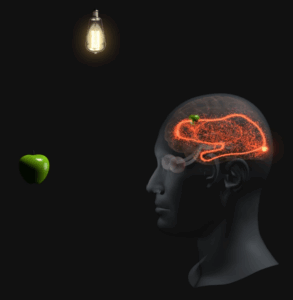 | Budich, Beatrice, Preim, Bernhard, Sabel, Bernhard A, Meuschke, Monique Narrative medical visualization to communicate vision restoration to patients: a case study Inproceedings Proc. of Eurographics Workshop on Visual Computing for Biology and Medicine, 2025. BibTeX | Links: @inproceedings{Budich2025VCBM, title = {Narrative medical visualization to communicate vision restoration to patients: a case study}, author = {Beatrice Budich and Bernhard Preim and Bernhard A Sabel and Monique Meuschke}, url = {https://isgwww.cs.ovgu.de/~meuschke/wp-content/uploads/2025/09/Budich2025VCBM.pdf}, year = {2025}, date = {2025-01-01}, urldate = {2025-01-01}, booktitle = {Proc. of Eurographics Workshop on Visual Computing for Biology and Medicine}, keywords = {}, pubstate = {published}, tppubtype = {inproceedings} } |
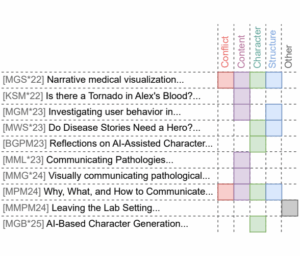 | Mittenentzwei, Sarah, Mlitzke, Sophie, Budich, Beatrice, Kleinau, Anna, Preim, Bernhard, Meuschke, Monique Visual Disease Stories: Empowering Health Literacy and Promotion Inproceedings Eurographics 2025 - Dirk Bartz Prize, The Eurographics Association, 2025. BibTeX | Links: @inproceedings{Mittenentzwei_2025_Bartz, title = {Visual Disease Stories: Empowering Health Literacy and Promotion}, author = {Sarah Mittenentzwei and Sophie Mlitzke and Beatrice Budich and Anna Kleinau and Bernhard Preim and Monique Meuschke}, url = {https://diglib.eg.org/items/8148fd9e-55cc-4403-80a3-eb4bf800b10a}, doi = {https://doi.org/10.2312/evm.20251972}, year = {2025}, date = {2025-01-01}, urldate = {2025-01-01}, booktitle = {Eurographics 2025 - Dirk Bartz Prize}, publisher = {The Eurographics Association}, keywords = {}, pubstate = {published}, tppubtype = {inproceedings} } |
2024 |
|
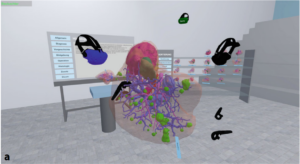 | Huber, Tobias, Huettl, Florentine, Vradelis, Lukas, Tripke, Verena, Schott, Danny, Chheang, Vuthea, Saalfeld, Patrick, Allgaier, Mareen, Saalfeld, Sylvia, Preim, Bernhard, Hansen, Christian, Hanke, Laura Isabel, Lang, Hauke Virtual Reality in der Leberchirurgie – Planen, Weiterbilden, Prüfen Journal Article Die Chirurgie, 2024. @article{Huber2024, title = {Virtual Reality in der Leberchirurgie – Planen, Weiterbilden, Prüfen}, author = {Tobias Huber and Florentine Huettl and Lukas Vradelis and Verena Tripke and Danny Schott and Vuthea Chheang and Patrick Saalfeld and Mareen Allgaier and Sylvia Saalfeld and Bernhard Preim and Christian Hansen and Laura Isabel Hanke and Hauke Lang}, doi = {https://doi.org/10.1007/s00104-024-02216-5}, year = {2024}, date = {2024-12-17}, journal = {Die Chirurgie}, abstract = {Bereits seit über 20 Jahren können anatomische Strukturen der Leber aus präoperativen Schnittbildgebungen dreidimensional rekonstruiert werden. Diese dreidimensionale (3D) Darstellung optimiert nicht nur die präoperativen Planungsmöglichkeiten, auch die Vermittlung spezifischer, operationsrelevanter Strukturen kann durch 3D-Modelle verbessert werden. Die disruptive Technologie der virtuellen Realität (VR) kann neben einer plastischen und interaktiven Visualisierung dreidimensionaler Organmodelle auch eine Möglichkeit zur strukturierten Aus- und Weiterbildung hinsichtlich leberchirurgischer Anatomie und Operationsplanung liefern. Prüfungen in virtueller Realität erscheinen dadurch ebenfalls greifbar. Neueste Prototypen ermöglichen sogar eine patientenindividuelle Simulation der intraoperativen Sonographie. Dieser Artikel stellt einen Überblick über den gegenwärtigen Stand der verfügbaren Technologien für Aus- und Weiterbildung mittels VR am Beispiel der Leberchirurgie dar.}, keywords = {}, pubstate = {published}, tppubtype = {article} } Bereits seit über 20 Jahren können anatomische Strukturen der Leber aus präoperativen Schnittbildgebungen dreidimensional rekonstruiert werden. Diese dreidimensionale (3D) Darstellung optimiert nicht nur die präoperativen Planungsmöglichkeiten, auch die Vermittlung spezifischer, operationsrelevanter Strukturen kann durch 3D-Modelle verbessert werden. Die disruptive Technologie der virtuellen Realität (VR) kann neben einer plastischen und interaktiven Visualisierung dreidimensionaler Organmodelle auch eine Möglichkeit zur strukturierten Aus- und Weiterbildung hinsichtlich leberchirurgischer Anatomie und Operationsplanung liefern. Prüfungen in virtueller Realität erscheinen dadurch ebenfalls greifbar. Neueste Prototypen ermöglichen sogar eine patientenindividuelle Simulation der intraoperativen Sonographie. Dieser Artikel stellt einen Überblick über den gegenwärtigen Stand der verfügbaren Technologien für Aus- und Weiterbildung mittels VR am Beispiel der Leberchirurgie dar. |
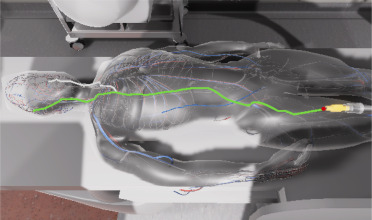 | Streuber, Marcus, Allgaier, Mareen, Schwab, Roland, Behme, Daniel, Saalfeld, Sylvia A VR neurointerventional setup for catheter-based interventions focusing on visualizing the risk of radiation Journal Article Computers in Biology and Medicine, 183 , pp. 109224, 2024, ISSN: 0010-4825. BibTeX | Links: @article{Streuber2024, title = {A VR neurointerventional setup for catheter-based interventions focusing on visualizing the risk of radiation}, author = {Marcus Streuber and Mareen Allgaier and Roland Schwab and Daniel Behme and Sylvia Saalfeld}, url = {https://www.vismd.de/wp-content/uploads/2025/12/1-s2.0-S001048252401309X-main.pdf}, doi = {10.1016/j.compbiomed.2024.109224}, issn = {0010-4825}, year = {2024}, date = {2024-10-19}, journal = {Computers in Biology and Medicine}, volume = {183}, pages = {109224}, keywords = {}, pubstate = {published}, tppubtype = {article} } |
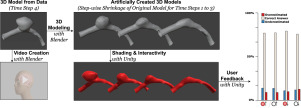 | Mittenentzwei, Sarah, Mlitzke, Sophie, Grisanova, Darija, Lawonn, Kai, Preim, Bernhard, Meuschke, Monique Visually communicating pathological changes: A case study on the effectiveness of phong versus outline shading Journal Article Computers & Graphics 2024, 2024. BibTeX | Links: @article{Mittenentzwei2024c, title = {Visually communicating pathological changes: A case study on the effectiveness of phong versus outline shading}, author = {Sarah Mittenentzwei and Sophie Mlitzke and Darija Grisanova and Kai Lawonn and Bernhard Preim and Monique Meuschke}, url = {https://www.sciencedirect.com/science/article/pii/S0097849324001584?via%3Dihub}, doi = {https://doi.org/10.1016/j.cag.2024.104023}, year = {2024}, date = {2024-10-01}, journal = {Computers & Graphics 2024}, keywords = {}, pubstate = {published}, tppubtype = {article} } |
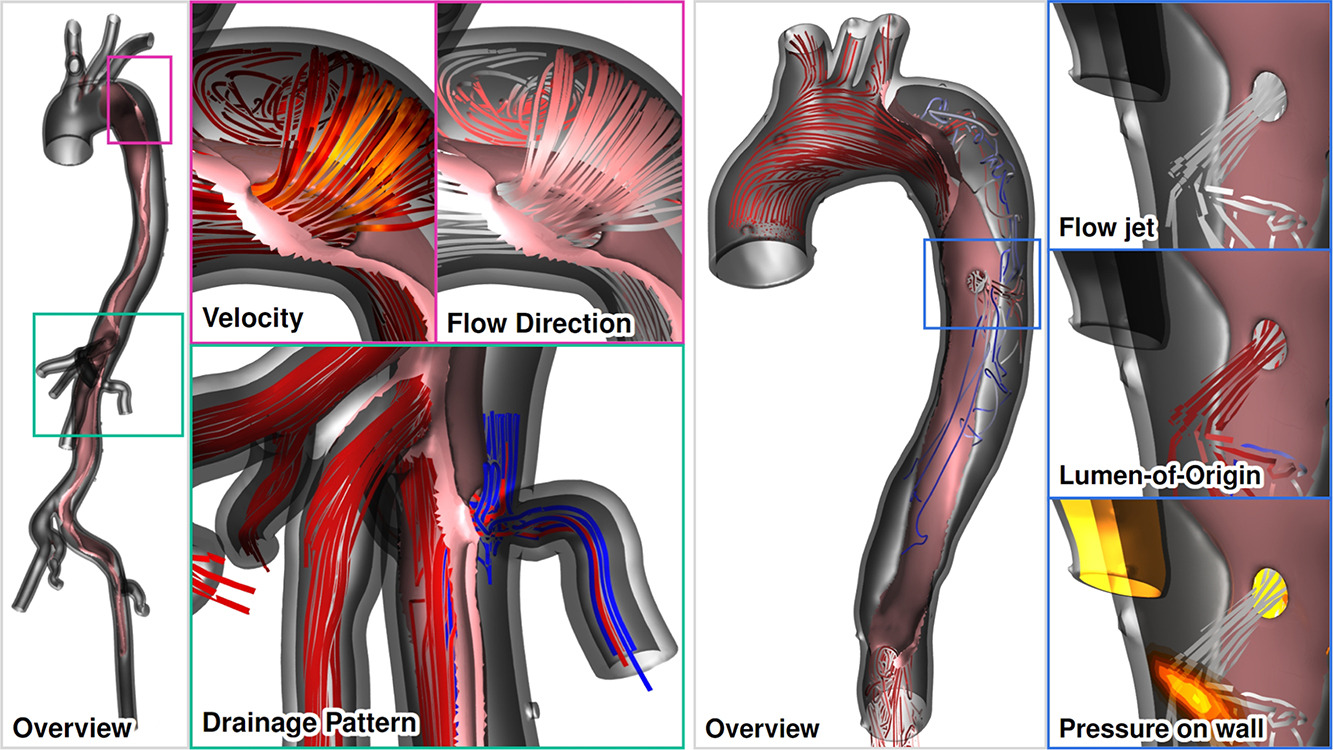 | Schroeder, Aaron, Ostendorf, Kai, Bäumler, Kathrin, Mastrodicasa, Domenico, Sandfort, Veit, Fleischmann, Dominik, Preim, Bernhard, Mistelbauer, Gabriel Advanced visualization of aortic dissection anatomy and hemodynamics Journal Article Computers & Graphics 2024, 124 , pp. 104060, 2024, ISSN: 0097-8493. @article{Schroeder2024, title = {Advanced visualization of aortic dissection anatomy and hemodynamics}, author = {Aaron Schroeder and Kai Ostendorf and Kathrin Bäumler and Domenico Mastrodicasa and Veit Sandfort and Dominik Fleischmann and Bernhard Preim and Gabriel Mistelbauer}, url = {https://www.sciencedirect.com/science/article/pii/S009784932400195X https://www.vismd.de/wp-content/uploads/2025/12/1-s2.0-S009784932400195X-main.pdf}, doi = {https://doi.org/10.1016/j.cag.2024.104060}, issn = {0097-8493}, year = {2024}, date = {2024-10-01}, journal = {Computers & Graphics 2024}, volume = {124}, pages = {104060}, abstract = {Aortic dissection is a life-threatening cardiovascular disease constituted by the delamination of the aortic wall. Due to the weakened structure of the false lumen, the aorta often dilates over time, which can – after certain diameter thresholds are reached – increase the risk of fatal aortic rupture. The identification of patients with a high risk of late adverse events is an ongoing clinical challenge, further complicated by the complex dissection anatomy and the wide variety among patients. Moreover, patient-specific risk stratification depends not only on morphological, but also on hemodynamic factors, which can be derived from computer simulations or 4D flow magnetic resonance imaging (MRI). However, comprehensible visualizations that depict the complex anatomical and functional information in a single view are yet to be developed. These visualization tools will assist clinical research and decision-making by facilitating a comprehensive understanding of the aortic state. For that purpose, we identified several visualization tasks and requirements in close collaboration with cardiovascular imaging scientists and radiologists. We displayed true and false lumen hemodynamics using pathlines as well as surface hemodynamics on the dissection flap and the inner vessel wall. Pathlines indicate antegrade and retrograde flow, blood flow through fenestrations, and branch vessel supply. Dissection-specific hemodynamic measures, such as interluminal pressure difference and flap compliance, provide further insight of the blood flow throughout the cardiac cycle. Finally, we evaluated our visualization techniques with cardiothoracic and vascular surgeons in two separate virtual sessions.}, keywords = {}, pubstate = {published}, tppubtype = {article} } Aortic dissection is a life-threatening cardiovascular disease constituted by the delamination of the aortic wall. Due to the weakened structure of the false lumen, the aorta often dilates over time, which can – after certain diameter thresholds are reached – increase the risk of fatal aortic rupture. The identification of patients with a high risk of late adverse events is an ongoing clinical challenge, further complicated by the complex dissection anatomy and the wide variety among patients. Moreover, patient-specific risk stratification depends not only on morphological, but also on hemodynamic factors, which can be derived from computer simulations or 4D flow magnetic resonance imaging (MRI). However, comprehensible visualizations that depict the complex anatomical and functional information in a single view are yet to be developed. These visualization tools will assist clinical research and decision-making by facilitating a comprehensive understanding of the aortic state. For that purpose, we identified several visualization tasks and requirements in close collaboration with cardiovascular imaging scientists and radiologists. We displayed true and false lumen hemodynamics using pathlines as well as surface hemodynamics on the dissection flap and the inner vessel wall. Pathlines indicate antegrade and retrograde flow, blood flow through fenestrations, and branch vessel supply. Dissection-specific hemodynamic measures, such as interluminal pressure difference and flap compliance, provide further insight of the blood flow throughout the cardiac cycle. Finally, we evaluated our visualization techniques with cardiothoracic and vascular surgeons in two separate virtual sessions. |
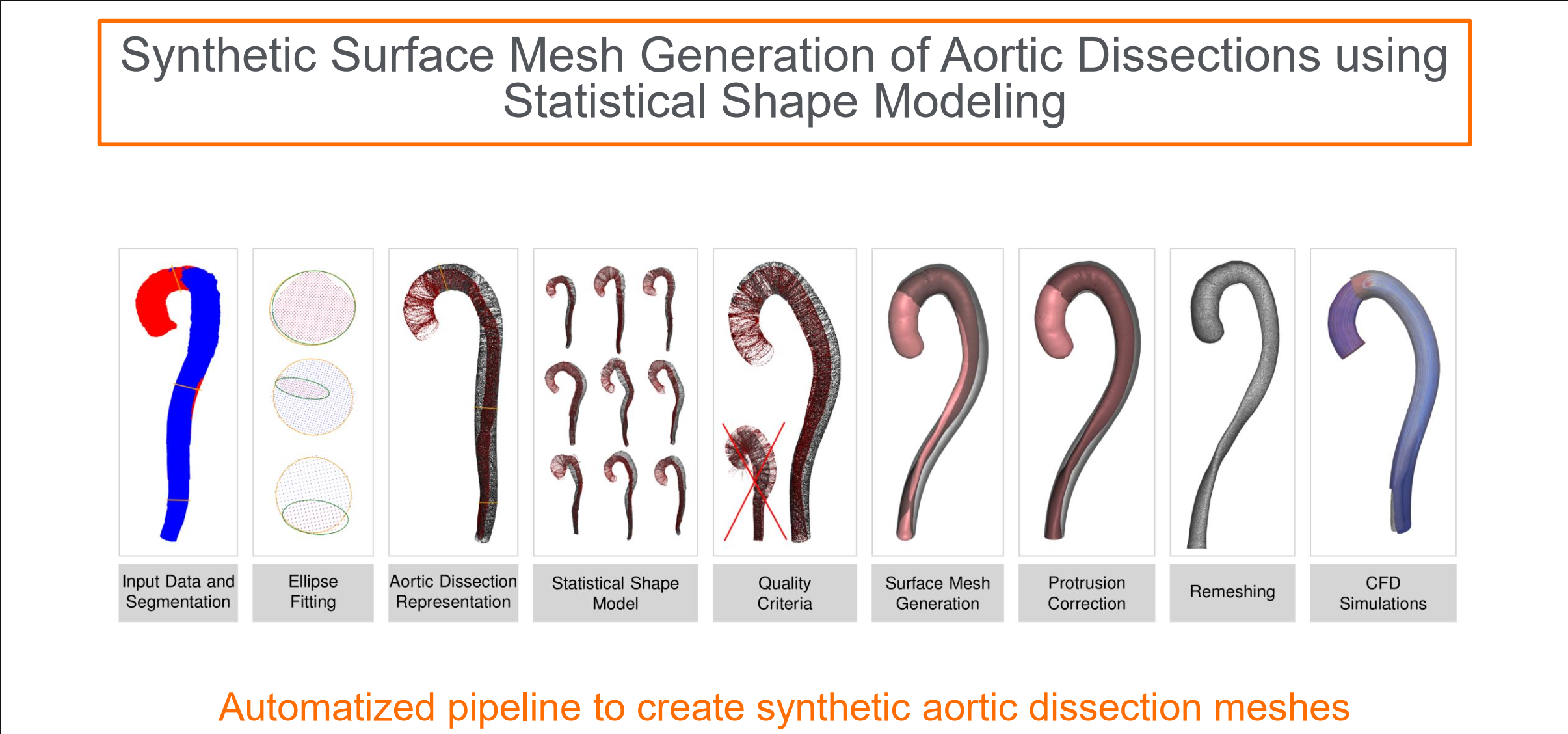 | Ostendorf, Kai, Bäumler, Kathrin, Mastrodicasa, Domenico, Fleischmann, Dominik, Preim, Bernhard, Mistelbauer, Gabriel Synthetic surface mesh generation of aortic dissections using statistical shape modeling Journal Article Computers & Graphics 2024, 124 , pp. 104070, 2024, ISSN: 0097-8493. @article{Ostendorf2024, title = {Synthetic surface mesh generation of aortic dissections using statistical shape modeling}, author = {Kai Ostendorf and Kathrin Bäumler and Domenico Mastrodicasa and Dominik Fleischmann and Bernhard Preim and Gabriel Mistelbauer}, url = {https://www.sciencedirect.com/science/article/pii/S009784932400205X https://www.vismd.de/wp-content/uploads/2025/12/1-s2.0-S009784932400205X-main.pdf}, doi = {https://doi.org/10.1016/j.cag.2024.104070}, issn = {0097-8493}, year = {2024}, date = {2024-10-01}, journal = {Computers & Graphics 2024}, volume = {124}, pages = {104070}, abstract = {Aortic dissection is a rare disease affecting the aortic wall layers splitting the aortic lumen into two flow channels: the true and false lumen. The rarity of the disease leads to a sparsity of available datasets resulting in a low amount of available training data for in-silico studies or the training of machine learning algorithms. To mitigate this issue, we use statistical shape modeling to create a database of Stanford type B dissection surface meshes. We account for the complex disease anatomy by modeling two separate flow channels in the aorta, the true and false lumen. Former approaches mainly modeled the aortic arch including its branches but not two separate flow channels inside the aorta. To our knowledge, our approach is the first to attempt generating synthetic aortic dissection surface meshes. For the statistical shape model, the aorta is parameterized using the centerlines of the respective lumen and the according ellipses describing the cross-section of the lumen while being aligned along the centerline employing rotation-minimizing frames. To evaluate our approach we introduce disease-specific quality criteria by investigating the torsion and twist of the true lumen.}, keywords = {}, pubstate = {published}, tppubtype = {article} } Aortic dissection is a rare disease affecting the aortic wall layers splitting the aortic lumen into two flow channels: the true and false lumen. The rarity of the disease leads to a sparsity of available datasets resulting in a low amount of available training data for in-silico studies or the training of machine learning algorithms. To mitigate this issue, we use statistical shape modeling to create a database of Stanford type B dissection surface meshes. We account for the complex disease anatomy by modeling two separate flow channels in the aorta, the true and false lumen. Former approaches mainly modeled the aortic arch including its branches but not two separate flow channels inside the aorta. To our knowledge, our approach is the first to attempt generating synthetic aortic dissection surface meshes. For the statistical shape model, the aorta is parameterized using the centerlines of the respective lumen and the according ellipses describing the cross-section of the lumen while being aligned along the centerline employing rotation-minimizing frames. To evaluate our approach we introduce disease-specific quality criteria by investigating the torsion and twist of the true lumen. |
 | Swiatek, Vanessa M, Amini, Amir, Marinescu, Michelle, Dumitru, Claudia A., Spitz, Lena Iam, Stein, Klaus-Peter, Saalfeld, Sylvia, Rashidi, Ali, Sandalcioglu, I. Erol, Neyazi, Belal Sex Differences in Intracranial Aneurysms: A Matched Cohort Study Journal Article Journal of Personalized Medicine, 14 (10), pp. 1038, 2024. BibTeX | Links: @article{Swiatek_JPersMed2024, title = {Sex Differences in Intracranial Aneurysms: A Matched Cohort Study}, author = {Vanessa M Swiatek and Amir Amini and Michelle Marinescu and Claudia A. Dumitru and Lena Iam Spitz and Klaus-Peter Stein and Sylvia Saalfeld and Ali Rashidi and I. Erol Sandalcioglu and Belal Neyazi}, doi = {https://doi.org/10.3390/jpm14101038}, year = {2024}, date = {2024-09-28}, journal = {Journal of Personalized Medicine}, volume = {14}, number = {10}, pages = {1038}, keywords = {}, pubstate = {published}, tppubtype = {article} } |
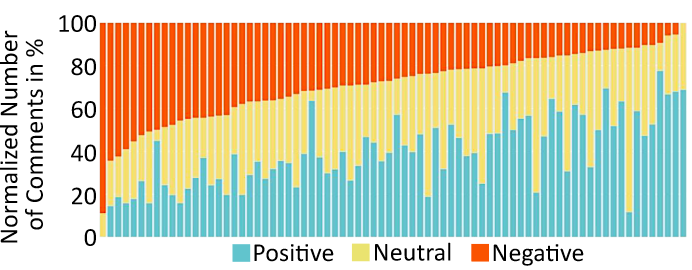 | Mittenentzwei, Sarah, Murad, Danish, Preim, Bernhard, Meuschke, Monique Leaving the Lab Setting: What We Can Learn About the Perception of Narrative Medical Visualizations from YouTube Comments Inproceedings Visual Computing for Biology and Medicine, 2024, 2024. BibTeX | Links: @inproceedings{Mittenentzwei2024, title = {Leaving the Lab Setting: What We Can Learn About the Perception of Narrative Medical Visualizations from YouTube Comments}, author = {Sarah Mittenentzwei and Danish Murad and Bernhard Preim and Monique Meuschke}, url = {https://diglib.eg.org/server/api/core/bitstreams/638591a4-87e2-4017-af5d-06ecc81d783a/content https://www.vismd.de/wp-content/uploads/2025/12/sarah_vcbm20241193.pdf}, doi = {https://doi.org/10.2312/vcbm.20241193}, year = {2024}, date = {2024-09-20}, booktitle = {Visual Computing for Biology and Medicine, 2024}, keywords = {}, pubstate = {published}, tppubtype = {inproceedings} } |
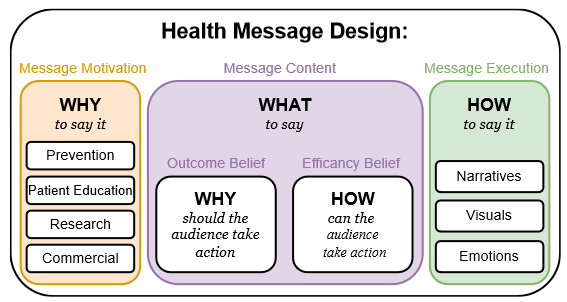 | Mittenentzwei, Sarah, Preim, Bernhard, Meuschke, Monique Why, What, and How to Communicate Health Information Visually: Reflections on the Design Process of Narrative Medical Visualization Inproceedings Visual Computing for Biology and Medicine, 2024, 2024. BibTeX | Links: @inproceedings{Mittenentzwei2024b, title = {Why, What, and How to Communicate Health Information Visually: Reflections on the Design Process of Narrative Medical Visualization}, author = {Sarah Mittenentzwei and Bernhard Preim and Monique Meuschke}, url = {https://diglib.eg.org/server/api/core/bitstreams/7b0308eb-c59f-436f-bb79-96037b7d508a/content https://www.vismd.de/wp-content/uploads/2025/12/sarah_why_what_vcbm20241192.pdf}, doi = {https://doi.org/10.2312/vcbm.20241192}, year = {2024}, date = {2024-09-20}, booktitle = {Visual Computing for Biology and Medicine, 2024}, keywords = {}, pubstate = {published}, tppubtype = {inproceedings} } |
Härtel, Tim, Allgaier, Mareen, Behme, Daniel, Preim, Bernhard, Saalfeld, Sylvia Virtual Reality Training for Inner Ear Anatomy Using Gamification Inproceedings Visual Computing for Biology and Medicine, 2024. @inproceedings{Haertel25, title = {Virtual Reality Training for Inner Ear Anatomy Using Gamification}, author = {Tim Härtel and Mareen Allgaier and Daniel Behme and Bernhard Preim and Sylvia Saalfeld}, year = {2024}, date = {2024-09-20}, booktitle = {Visual Computing for Biology and Medicine}, keywords = {}, pubstate = {published}, tppubtype = {inproceedings} } | |
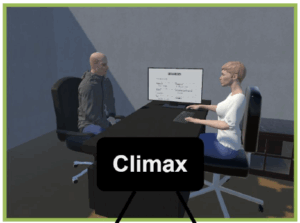 | Maienschein, Theresa, Allgaier, Mareen, Huettl, Florentine, Huber, Tobias, Preim, Bernhard, Meuschke, Monique Virtual Tales: Narrative Virtual Reality for Patient Education Inproceedings Visual Computing for Biology and Medicine, 2024. BibTeX | Links: @inproceedings{Maienschein24, title = {Virtual Tales: Narrative Virtual Reality for Patient Education}, author = {Theresa Maienschein and Mareen Allgaier and Florentine Huettl and Tobias Huber and Bernhard Preim and Monique Meuschke}, url = {https://www.vismd.de/wp-content/uploads/2025/09/Maienschein_VCBM2024.pdf}, year = {2024}, date = {2024-09-20}, booktitle = {Visual Computing for Biology and Medicine}, journal = {Visual Computing for Biology and Medicine}, keywords = {}, pubstate = {published}, tppubtype = {inproceedings} } |
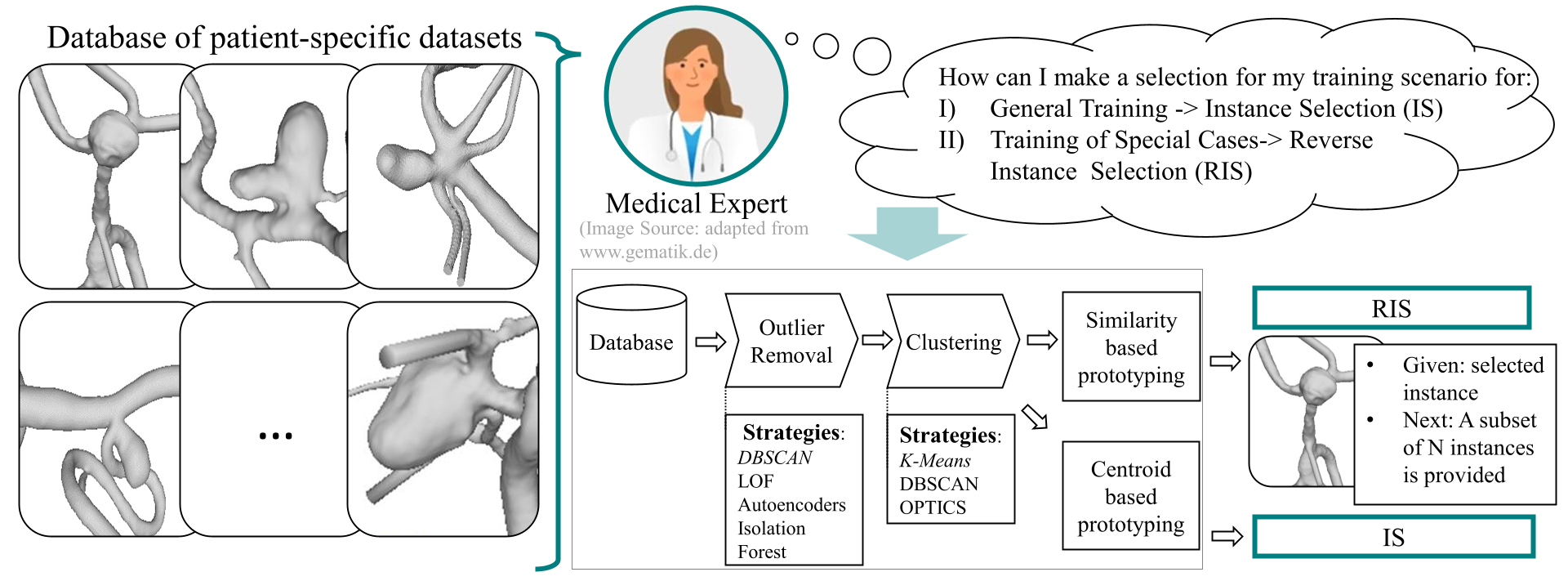 | Spitz, Lena Iam, Umeh, Stanley Chukwuemeka, Behme, Daniel, Neyazi, Belal, Sandalcioglu, I. Erol, Preim, Bernhard, Saalfeld, Sylvia Subset selection for intracranial aneurysms for training simulations Journal Article Current Directions in Biomedical Engineering , 10 (1), pp. 73-76, 2024. BibTeX | Links: @article{Spitz_2024_CURACb, title = {Subset selection for intracranial aneurysms for training simulations}, author = {Lena Iam Spitz and Stanley Chukwuemeka Umeh and Daniel Behme and Belal Neyazi and I. Erol Sandalcioglu and Bernhard Preim and Sylvia Saalfeld }, url = {https://www.vismd.de/wp-content/uploads/2025/12/spitz_10.1515_cdbme-2024-0119.pdf}, doi = {https://doi.org/10.1515/cdbme-2024-0119}, year = {2024}, date = {2024-09-12}, journal = {Current Directions in Biomedical Engineering }, volume = {10}, number = {1}, pages = {73-76}, keywords = {}, pubstate = {published}, tppubtype = {article} } |
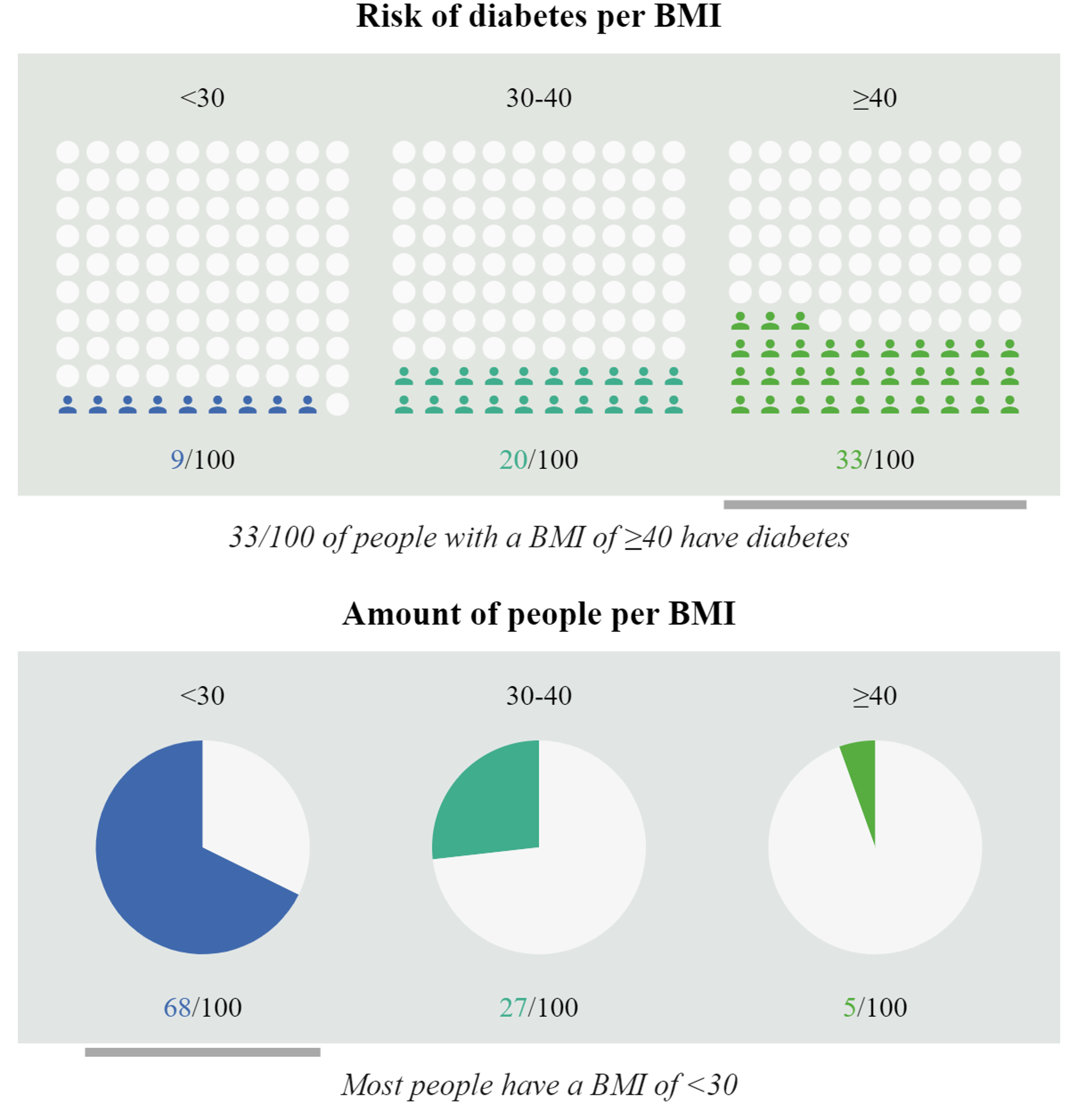 | Kleinau, Anna, Preim, Bernhard, Meuschke, Monique Raccoon: Supporting Risk Communicators in Visualizing Health Data for the Public Inproceedings Vision, Modeling, and Visualization, The Eurographics Association, 2024, ISBN: 978-3-03868-247-9. BibTeX | Links: @inproceedings{Kleinau2024, title = {Raccoon: Supporting Risk Communicators in Visualizing Health Data for the Public}, author = {Anna Kleinau and Bernhard Preim and Monique Meuschke}, url = {https://www.vismd.de/wp-content/uploads/2025/12/ANNA_vmv20241200.pdf}, doi = {10.2312/vmv.20241200}, isbn = {978-3-03868-247-9}, year = {2024}, date = {2024-09-12}, booktitle = {Vision, Modeling, and Visualization}, publisher = {The Eurographics Association}, keywords = {}, pubstate = {published}, tppubtype = {inproceedings} } |
 | Spitz, Lena Iam, Schmidt, Jessica, Korte, Jana, Berg, Philipp, Behme, Daniel, Neyazi, Belal, Preim, Bernhard, Saalfeld, Sylvia Morphologic and hemodynamic analysis of intracranial mirror aneurysms Journal Article Current Directions in Biomedical Engineering , 10 (2), pp. 87-90, 2024. BibTeX | Links: @article{Spitz_2023_CURACb, title = {Morphologic and hemodynamic analysis of intracranial mirror aneurysms}, author = {Lena Iam Spitz and Jessica Schmidt and Jana Korte and Philipp Berg and Daniel Behme and Belal Neyazi and Bernhard Preim and Sylvia Saalfeld}, doi = {https://doi.org/10.1515/cdbme-2024-1074}, year = {2024}, date = {2024-09-10}, journal = { Current Directions in Biomedical Engineering }, volume = {10}, number = {2}, pages = {87-90}, keywords = {}, pubstate = {published}, tppubtype = {article} } |
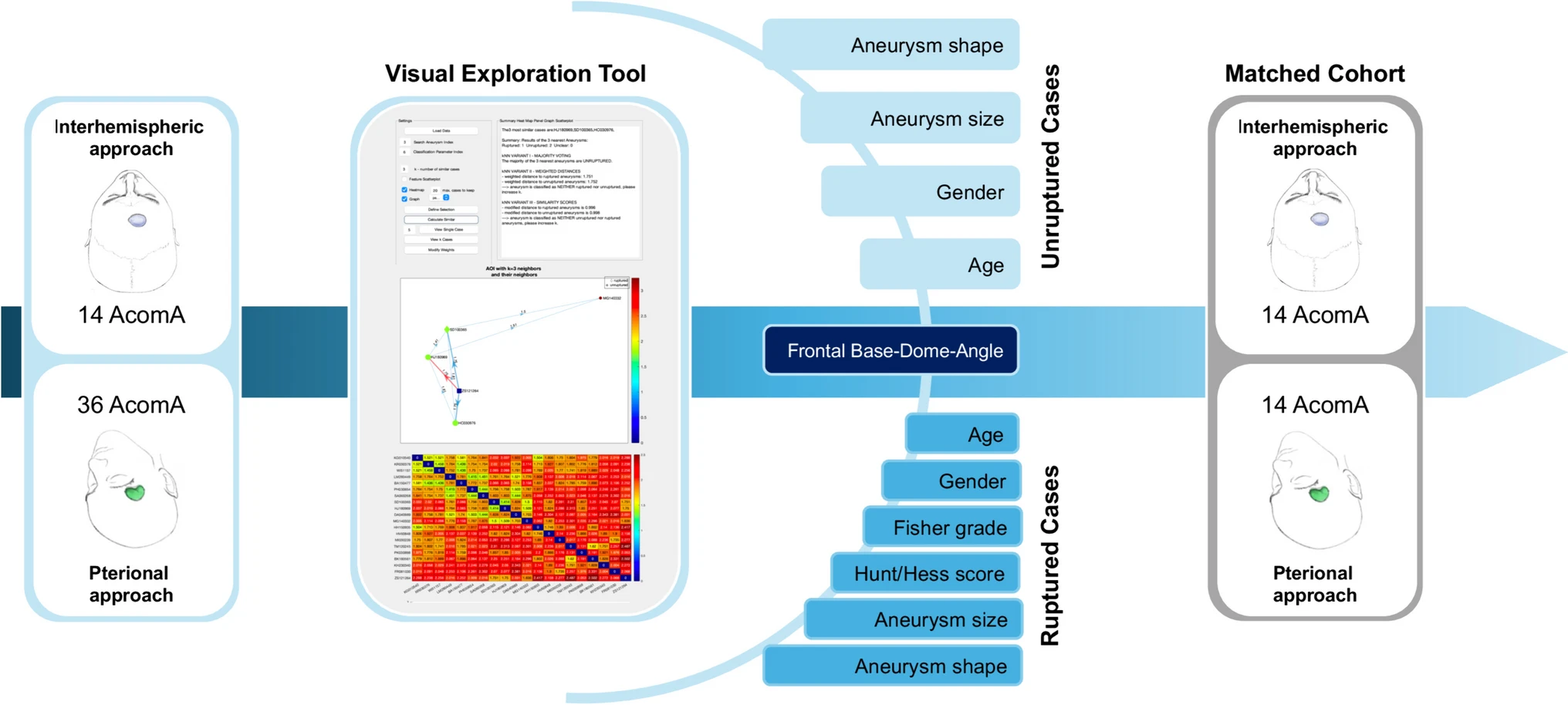 | Swiatek, Vanessa M, Amini, Amir, Spitz, Lena Iam, Rashidi, Ali, Dumitru, Claudia A., Stein, Klaus-Peter, Sylvia, Saalfeld,, Sandalcioglu, I. Erol, Neyazi, Belal Anterior interhemispheric vs. pterional approach in the microsurgical management of anterior communicating artery aneurysms: a comparative analysis employing a novel multidimensional matching-tool Journal Article Neurosurgical Review, 47 (366), 2024. BibTeX | Links: @article{SwiatekNeurosurgReview2024, title = {Anterior interhemispheric vs. pterional approach in the microsurgical management of anterior communicating artery aneurysms: a comparative analysis employing a novel multidimensional matching-tool}, author = {Vanessa M Swiatek and Amir Amini and Lena Iam Spitz and Ali Rashidi and Claudia A. Dumitru and Klaus-Peter Stein and Saalfeld, Sylvia and I. Erol Sandalcioglu and Belal Neyazi}, doi = {https://doi.org/10.1007/s10143-024-02592-w}, year = {2024}, date = {2024-07-29}, journal = {Neurosurgical Review}, volume = {47}, number = {366}, keywords = {}, pubstate = {published}, tppubtype = {article} } |
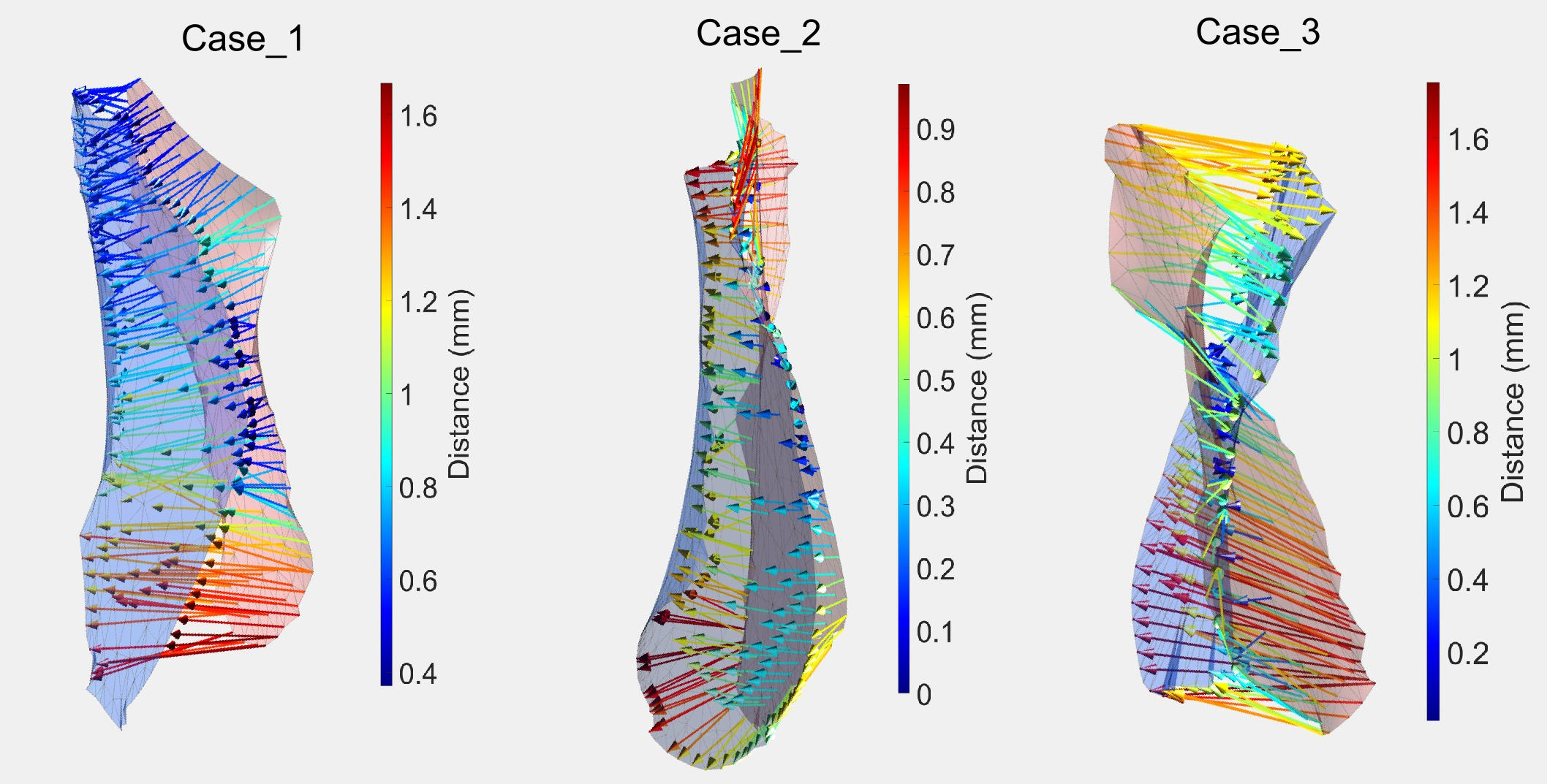 | Spitz, Lena Iam, Korte, Jana, Gaidzik, Franziska, Larsen, Naomi, Preim, Bernhard, Saalfeld, Sylvia Assessment of intracranial aneurysm neck deformation after contour deployment Journal Article International Journal of Computer Assisted Radiology and Surgery, 2024. BibTeX | Links: @article{SpitzIJCARS2024, title = {Assessment of intracranial aneurysm neck deformation after contour deployment}, author = {Lena Iam Spitz and Jana Korte and Franziska Gaidzik and Naomi Larsen and Bernhard Preim and Sylvia Saalfeld}, doi = {https://doi.org/10.1007/s11548-024-03189-w}, year = {2024}, date = {2024-05-31}, journal = {International Journal of Computer Assisted Radiology and Surgery}, keywords = {}, pubstate = {published}, tppubtype = {article} } |
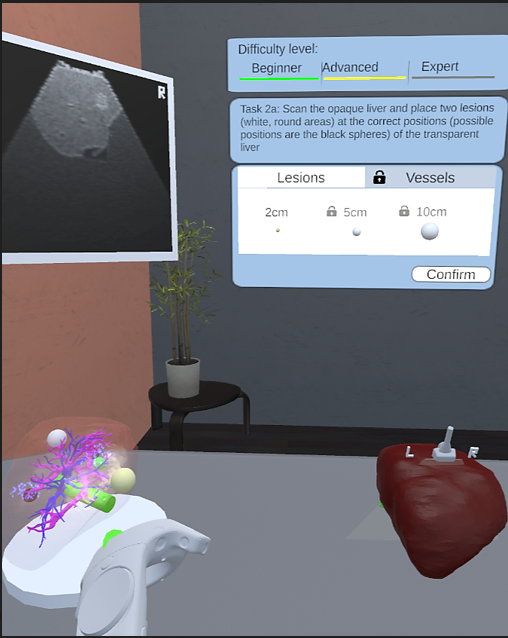 | Allgaier, Mareen, Huettl, Florentine, Hanka, L., Huber, Tobias, Preim, Bernhard, Saalfeld, Sylvia, Hansen, Christian Gamification Concepts for a VR-based Visuospatial Training for Intraoperative Liver Ultrasound Inproceedings Extended Abstracts of the CHI Conference on Human Factors in Computing Systems , Association for Computing Machinery, 2024, ISBN: 9798400703317. BibTeX | Links: @inproceedings{Allgaier_2024_CHI, title = {Gamification Concepts for a VR-based Visuospatial Training for Intraoperative Liver Ultrasound}, author = {Mareen Allgaier and Florentine Huettl and L. Hanka and Tobias Huber and Bernhard Preim and Sylvia Saalfeld and Christian Hansen}, doi = {10.1145/3613905.3650736 }, isbn = {9798400703317}, year = {2024}, date = {2024-05-15}, booktitle = {Extended Abstracts of the CHI Conference on Human Factors in Computing Systems }, number = {175}, publisher = {Association for Computing Machinery}, series = {CHI EA '24}, keywords = {}, pubstate = {published}, tppubtype = {inproceedings} } |
Belger, Julia, Wagner, Sebastian, Gaebler, Michael, Karnath, Hans-Otto, Preim, Bernhard, Saalfeld, Patrick, Schatz, Anna, Villringer, Arno, Thöne-Otto, Angelika Application of immersive virtual reality for assessing chronic neglect in individuals with stroke: the immersive virtual road-crossing task Journal Article JOURNAL OF CLINICAL AND EXPERIMENTAL NEUROPSYCHOLOGY , pp. 1-18, 2024. BibTeX | Links: @article{Belger_2024, title = {Application of immersive virtual reality for assessing chronic neglect in individuals with stroke: the immersive virtual road-crossing task }, author = {Julia Belger and Sebastian Wagner and Michael Gaebler and Hans-Otto Karnath and Bernhard Preim and Patrick Saalfeld and Anna Schatz and Arno Villringer and Angelika Thöne-Otto}, doi = {10.1080/13803395.2024.2329380 }, year = {2024}, date = {2024-03-25}, journal = {JOURNAL OF CLINICAL AND EXPERIMENTAL NEUROPSYCHOLOGY }, pages = {1-18}, keywords = {}, pubstate = {published}, tppubtype = {article} } | |
Kreher, Robert, Chitti, Naveeth Reddy, Hille, Georg, Hürtgen, Janine, Mengonie, Miriam, Braun, Andreas, Tüting, Thomas, Preim, Bernhard, Saalfeld, Sylvia Advanced Deep Learning for Skin Histoglyphics at Cellular Level Inproceedings BVM 2024: Bildverarbeitung für die Medizin 2024, pp. 66-71, Springer Verlag, 2024. BibTeX | Links: @inproceedings{Kreher_BVM_2024, title = {Advanced Deep Learning for Skin Histoglyphics at Cellular Level}, author = {Robert Kreher and Naveeth Reddy Chitti and Georg Hille and Janine Hürtgen and Miriam Mengonie and Andreas Braun and Thomas Tüting and Bernhard Preim and Sylvia Saalfeld }, doi = {https://doi.org/10.1007/978-3-658-44037-4_20}, year = {2024}, date = {2024-02-20}, booktitle = {BVM 2024: Bildverarbeitung für die Medizin 2024}, pages = {66-71}, publisher = {Springer Verlag}, keywords = {}, pubstate = {published}, tppubtype = {inproceedings} } | |
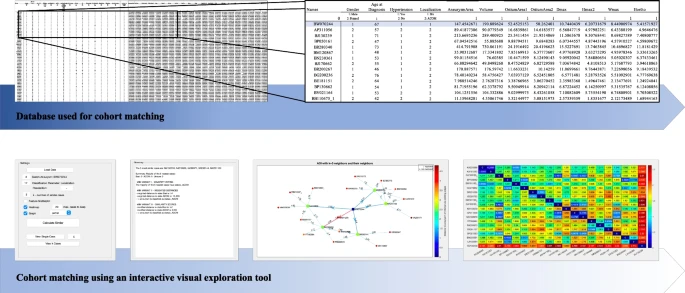 | Swiatek, Vanessa M, Amini, Amir, Ortuño, Celina E. Sandalcioglu, Spitz, Lena Iam, Hartmann, Karl, Rashidi, Ali, Stein, Klaus-Peter, Sylvia, Saalfeld,, Sandalcioglu, I. Erol, Neyazi, Belal Unveiling rupture risk and clinical outcomes in midline aneurysms: A matched cohort analysis investigating the impact of localization within the anterior or posterior circulation Journal Article Neurosurgical Review, 47 (76), 2024. BibTeX | Links: @article{Swiatek2024, title = {Unveiling rupture risk and clinical outcomes in midline aneurysms: A matched cohort analysis investigating the impact of localization within the anterior or posterior circulation}, author = {Vanessa M Swiatek and Amir Amini and Celina E. Sandalcioglu Ortuño and Lena Iam Spitz and Karl Hartmann and Ali Rashidi and Klaus-Peter Stein and Saalfeld, Sylvia and I. Erol Sandalcioglu and Belal Neyazi}, doi = {http://dx.doi.org/10.1007/s10143-024-02310-6}, year = {2024}, date = {2024-02-07}, journal = {Neurosurgical Review}, volume = {47}, number = {76}, keywords = {}, pubstate = {published}, tppubtype = {article} } |
Chheang, Vuthea, Saalfeld, Patrick, Joeres, Fabian, Boedecker, Christian, Huber, Tobias, Huettl, Florentine, Lang, Hauke, Preima, Bernhard, Hansen, Christian A collaborative virtual reality environment for liver surgery planning Journal Article Computers & Graphics, pp. in print, 2024. BibTeX | Links: @article{Chheang_CGF, title = {A collaborative virtual reality environment for liver surgery planning}, author = {Vuthea Chheang and Patrick Saalfeld and Fabian Joeres and Christian Boedecker and Tobias Huber and Florentine Huettl and Hauke Lang and Bernhard Preima and Christian Hansen}, doi = {https://doi.org/10.1016/j.cag.2021.07.009}, year = {2024}, date = {2024-01-22}, journal = {Computers & Graphics}, pages = {in print}, keywords = {}, pubstate = {published}, tppubtype = {article} } | |
 | Preim, Bernhard, Meuschke, Monique, Weiß, Veronika A Survey of Medical Visualization through the Lens of Metaphors Journal Article IEEE Transactions on Visualization and Computer Graphics, 30 (10), 2024. BibTeX | Links: @article{Preim_2023_TVCG, title = {A Survey of Medical Visualization through the Lens of Metaphors }, author = {Bernhard Preim and Monique Meuschke and Veronika Weiß }, url = {https://ieeexplore.ieee.org/document/10311416 https://isgwww.cs.uni-magdeburg.de/medvismetaphors/}, doi = {10.1109/TVCG.2023.3330546 }, year = {2024}, date = {2024-01-01}, journal = {IEEE Transactions on Visualization and Computer Graphics}, volume = {30}, number = {10}, keywords = {}, pubstate = {published}, tppubtype = {article} } |
 | Dowlatabadi, Sophia, Preim, Bernhard, Meuschke, Monique Visualization of Age Distributions as Elements of Medical Data-Stories Journal Article arXiv preprint arXiv:2409.17854, 2024. BibTeX | Links: @article{dowlatabadi2024visualization, title = {Visualization of Age Distributions as Elements of Medical Data-Stories}, author = {Sophia Dowlatabadi and Bernhard Preim and Monique Meuschke}, url = {https://arxiv.org/pdf/2409.17854}, year = {2024}, date = {2024-01-01}, urldate = {2024-01-01}, journal = {arXiv preprint arXiv:2409.17854}, keywords = {}, pubstate = {published}, tppubtype = {article} } |
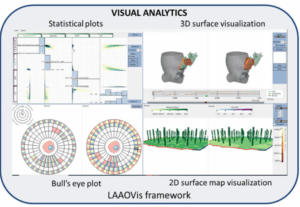 | Nuhic, Jasna, Albors, Carlos, Mill, Jordi, Olivares, Andy L, Camara, Oscar, Meuschke, Monique Comparative visualization of in-silico hemodynamic indices with different left atrial appendage occluder configurations Inproceedings Proc. of Computer Assisted Radiology and Surgery, 2024. BibTeX | Links: @inproceedings{Nuhic_CARS_24, title = {Comparative visualization of in-silico hemodynamic indices with different left atrial appendage occluder configurations}, author = {Jasna Nuhic and Carlos Albors and Jordi Mill and Andy L Olivares and Oscar Camara and Monique Meuschke}, url = {https://link.springer.com/content/pdf/10.1007/s11548-024-03128-9.pdf}, doi = {https://doi.org/10.1007/s11548-024-03128-9}, year = {2024}, date = {2024-01-01}, booktitle = {Proc. of Computer Assisted Radiology and Surgery}, volume = {19}, keywords = {}, pubstate = {published}, tppubtype = {inproceedings} } |
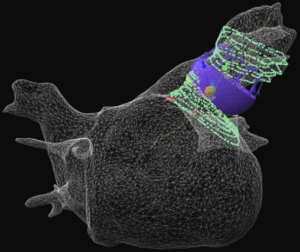 | Nuhic, Jasna, Albors, Carlos, Mill, Jordi, Olivares, Andy L, Camara, Oscar, Meuschke, Monique Visual Analytics for Planning Left Atrial Appendage Occlusion: A Case Study on In-silico Hemodynamic Assessment Inproceedings EuroVis 2024 - Short Papers, 2024. BibTeX | Links: @inproceedings{Nuhic_EuroVis_24, title = {Visual Analytics for Planning Left Atrial Appendage Occlusion: A Case Study on In-silico Hemodynamic Assessment}, author = {Jasna Nuhic and Carlos Albors and Jordi Mill and Andy L Olivares and Oscar Camara and Monique Meuschke}, url = {https://diglib.eg.org/bitstreams/6e3edc3f-4ed3-47a1-be5d-e86eb3927f20/download}, doi = {10.2312/evs.20241065}, year = {2024}, date = {2024-01-01}, booktitle = {EuroVis 2024 - Short Papers}, keywords = {}, pubstate = {published}, tppubtype = {inproceedings} } |
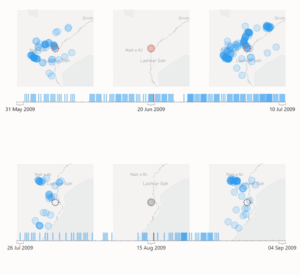 | Mayer, Benedikt, Donnay, Karsten, Lawonn, Kai, Preim, Bernhard, Meuschke, Monique Expert exploranation for communicating scientific methods - A case study in conflict research Journal Article Computers & Graphics, 120 , pp. 103937, 2024. BibTeX | Links: @article{Mayer2024b, title = {Expert exploranation for communicating scientific methods - A case study in conflict research}, author = {Benedikt Mayer and Karsten Donnay and Kai Lawonn and Bernhard Preim and Monique Meuschke}, url = {https://www.sciencedirect.com/science/article/pii/S0097849324000724?via%3Dihub}, doi = {https://doi.org/10.1016/j.cag.2024.103937}, year = {2024}, date = {2024-01-01}, urldate = {2024-01-01}, journal = {Computers & Graphics}, volume = {120}, pages = {103937}, publisher = {Elsevier}, keywords = {}, pubstate = {published}, tppubtype = {article} } |
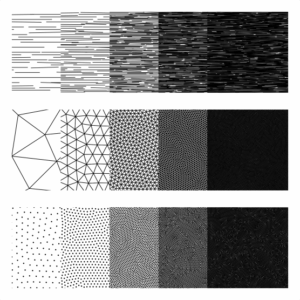 | Sterzik, Anna, Meuschke, Monique, Cunningham, Douglas W, Lawonn, Kai Perceptually Uniform Construction of Illustrative Textures Journal Article IEEE Transactions on Visualization and Computer Graphics, 30 (1), pp. 1052–1062, 2024. BibTeX | Links: @article{Sterzik2023_TVCG, title = {Perceptually Uniform Construction of Illustrative Textures}, author = {Anna Sterzik and Monique Meuschke and Douglas W Cunningham and Kai Lawonn}, url = {https://arxiv.org/abs/2308.03644}, doi = {https://doi.org/10.1109/TVCG.2023.3326574}, year = {2024}, date = {2024-01-01}, urldate = {2024-01-01}, journal = {IEEE Transactions on Visualization and Computer Graphics}, volume = {30}, number = {1}, pages = {1052–1062}, keywords = {}, pubstate = {published}, tppubtype = {article} } |
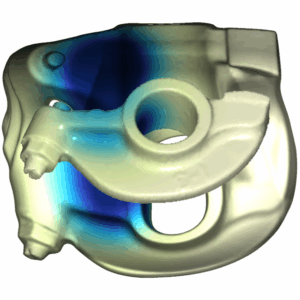 | Lawonn, Kai, Meuschke, Monique, Günther, Tobias InverseVis: Revealing the Hidden with Curved Sphere Tracing Journal Article Computer Graphics Forum, 43 (3), pp. in print, 2024. BibTeX | Links: @article{Lawonn2024_CGF, title = {InverseVis: Revealing the Hidden with Curved Sphere Tracing}, author = {Kai Lawonn and Monique Meuschke and Tobias Günther}, url = {https://onlinelibrary.wiley.com/doi/epdf/10.1111/cgf.15080 https://youtu.be/fJxXrmTOkMU}, doi = {https://doi.org/10.1111/cgf.15080}, year = {2024}, date = {2024-01-01}, urldate = {2024-01-01}, journal = {Computer Graphics Forum}, volume = {43}, number = {3}, pages = {in print}, keywords = {}, pubstate = {published}, tppubtype = {article} } |
2023 |
|
Ebel, Sebastian, Köhler, Benjamin, Aggarwal, Abhinav, Preim, Bernhard, Behrendt, Benjamin, Jung, Bernd, Gohmann, Robin F., Riekena, Boris, Borger, Michael, Lurz, Philipp, Denecke, Timm, Grothoff, Matthias, Gutberlet, Matthias Comparison of aortic blood flow rotational direction in healthy volunteers and patients with bicuspid aortic valves using volumetric velocity-sensitive cardiovascular magnetic resonance imaging Journal Article Quantitative Imaging in Medicine and Surgery, pp. 1-14, 2023. BibTeX | Links: @article{Ebel_2023, title = {Comparison of aortic blood flow rotational direction in healthy volunteers and patients with bicuspid aortic valves using volumetric velocity-sensitive cardiovascular magnetic resonance imaging}, author = {Sebastian Ebel and Benjamin Köhler and Abhinav Aggarwal and Bernhard Preim and Benjamin Behrendt and Bernd Jung and Robin F. Gohmann and Boris Riekena and Michael Borger and Philipp Lurz and Timm Denecke and Matthias Grothoff and Matthias Gutberlet}, url = {https://qims.amegroups.org/article/view/118594}, doi = {https://dx.doi.org/10.21037/qims-23-183}, year = {2023}, date = {2023-11-14}, journal = {Quantitative Imaging in Medicine and Surgery}, pages = {1-14}, keywords = {}, pubstate = {published}, tppubtype = {article} } | |
Kostiuchik, Georgii, Sharan, Lalith, Mayer, Benedikt, Wolf, Ivo, Preim, Bernhard, Engelhardt, Sandy Surgical Phase and Instrument Recognition: How to identify appropriate Dataset Splits Journal Article International Journal of Computer Assisted Radiology and Surgery, pp. 21, 2023. BibTeX | Links: @article{Kostiuchik_JCARS_2023, title = {Surgical Phase and Instrument Recognition: How to identify appropriate Dataset Splits}, author = {Georgii Kostiuchik and Lalith Sharan and Benedikt Mayer and Ivo Wolf and Bernhard Preim and Sandy Engelhardt}, doi = {https://doi.org/10.48550/arXiv.2306.16879}, year = {2023}, date = {2023-10-31}, journal = {International Journal of Computer Assisted Radiology and Surgery}, pages = {21}, keywords = {}, pubstate = {published}, tppubtype = {article} } | |
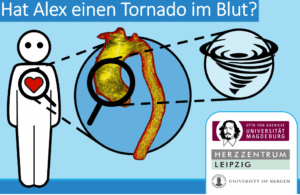 | Preim, Bernhard, Meuschke, Monique Narrative Visualisierung in der Medizin Journal Article IMAGE. Zeitschrift für interdisziplinäre Bildwissenschaft, 38, 19. Jg., (2) , pp. 94-112, 2023, ISBN: 1614-0885. BibTeX | Links: @article{Preim_2023_Image, title = {Narrative Visualisierung in der Medizin}, author = {Bernhard Preim and Monique Meuschke}, url = {https://image-journal.de/narrative-visualisierung-in-der-medizin/}, doi = {10.1453/1614-0885-2-2023-15739}, isbn = {1614-0885}, year = {2023}, date = {2023-10-26}, journal = {IMAGE. Zeitschrift für interdisziplinäre Bildwissenschaft}, volume = {38, 19. Jg., (2)}, pages = {94-112}, keywords = {}, pubstate = {published}, tppubtype = {article} } |
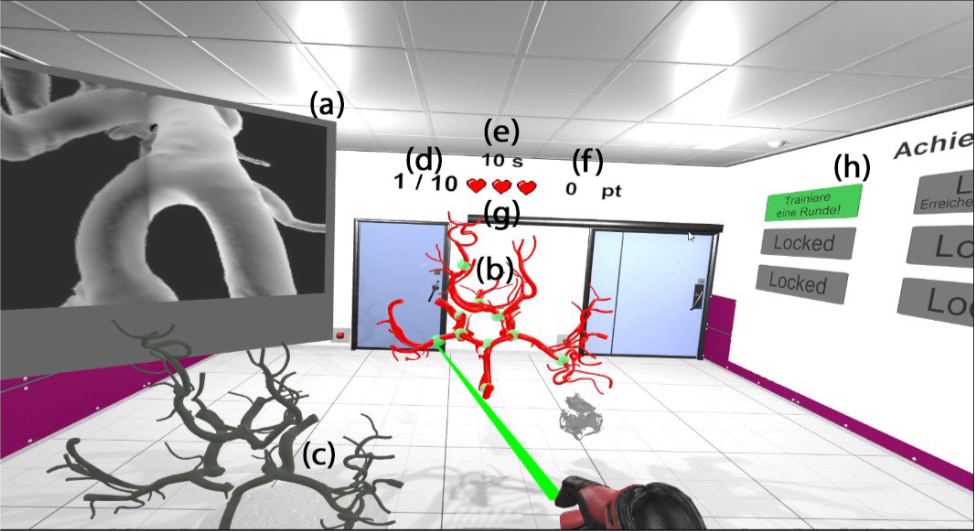 | Allgaier, Mareen, Härtel, Tim Jered, Zubel, Seraphine, Thormann, Maximilian, Behme, Daniel, Preim, Bernhard, Saalfeld, Sylvia Gamified Virtual Reality Training for Visuospatial Ability in Neuroradiology Journal Article Current Directions in Biomedical Engineering, 10 (2), pp. 25-28, 2023. BibTeX | Links: @article{Allgaier_2023_CURAC, title = {Gamified Virtual Reality Training for Visuospatial Ability in Neuroradiology}, author = {Mareen Allgaier and Tim Jered Härtel and Seraphine Zubel and Maximilian Thormann and Daniel Behme and Bernhard Preim and Sylvia Saalfeld}, doi = {10.1515/cdbme-2024-1058}, year = {2023}, date = {2023-09-14}, booktitle = {Jahrestagung der Deutschen Gesellschaft für Computer- und Roboterassistierte Chirurgie e.V., 2023}, journal = {Current Directions in Biomedical Engineering}, volume = {10}, number = {2}, pages = {25-28}, keywords = {}, pubstate = {published}, tppubtype = {article} } |
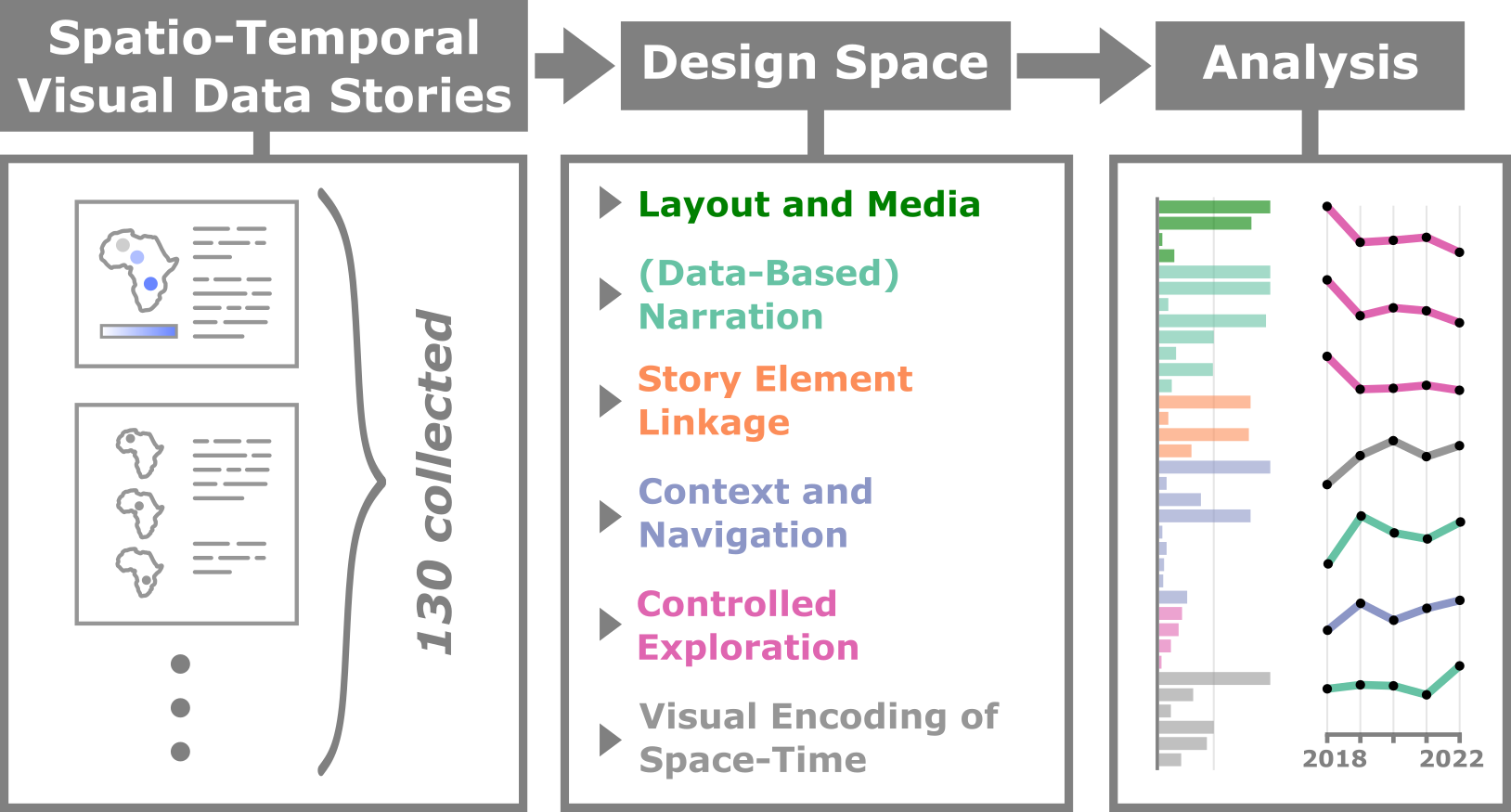 | Mayer, Benedikt, Steinhauer, Nastasja, Preim, Bernhard, Meuschke, Monique A Characterization of Interactive Visual Data Stories With a Spatio-Temporal Context Journal Article Computer Graphics Forum, n/a (n/a), pp. e14922, 2023. BibTeX | Links: @article{https://doi.org/10.1111/cgf.14922, title = {A Characterization of Interactive Visual Data Stories With a Spatio-Temporal Context}, author = {Benedikt Mayer and Nastasja Steinhauer and Bernhard Preim and Monique Meuschke}, url = {https://onlinelibrary.wiley.com/doi/abs/10.1111/cgf.14922}, doi = {https://doi.org/10.1111/cgf.14922}, year = {2023}, date = {2023-08-18}, journal = {Computer Graphics Forum}, volume = {n/a}, number = {n/a}, pages = {e14922}, keywords = {}, pubstate = {published}, tppubtype = {article} } |
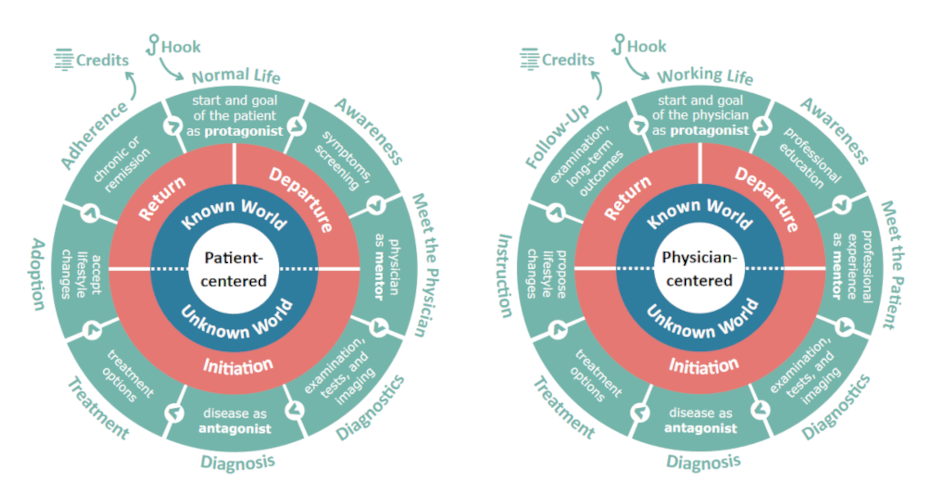 | Mittenentzwei, Sarah, Weiß, Veronika, Schreiber, Steffi, Garrison, Laura, Bruckner, Stefan, Pfister, M., Preim, Bernhard, Meuschke, Monique Do Disease Stories need a Hero? Effects of Human Protagonists on a Narrative Visualization about Cerebral Small Vessel Disease Journal Article Computer Graphics Forum, 42 (3), pp. 123-135, 2023. BibTeX | Links: @article{Mittenentzwei_2023_CGF, title = {Do Disease Stories need a Hero? Effects of Human Protagonists on a Narrative Visualization about Cerebral Small Vessel Disease}, author = {Sarah Mittenentzwei and Veronika Weiß and Steffi Schreiber and Laura Garrison and Stefan Bruckner and M. Pfister and Bernhard Preim and Monique Meuschke}, url = {https://vis.uib.no/wp-content/papercite-data/pdfs/garrison-diseasestories.pdf}, doi = {https://doi.org/10.1111/cgf.14817}, year = {2023}, date = {2023-06-19}, journal = {Computer Graphics Forum}, volume = {42}, number = {3}, pages = {123-135}, keywords = {}, pubstate = {published}, tppubtype = {article} } |
Schuette, Charlotte, Streuber, Marcus, Pottgiesser, Vivien, Preim, Bernhard, Saalfeld, Patrick, Vahlbruch, Jan-Willem, Walther, Clemens A teaching concept for school experiments on radioactivity using augmented reality methods Journal Article Radiation Protection Dosimetry, 199 (8-9), pp. 716-724, 2023. BibTeX | Links: @article{Schuette_2023_RPD, title = {A teaching concept for school experiments on radioactivity using augmented reality methods}, author = {Charlotte Schuette and Marcus Streuber and Vivien Pottgiesser and Bernhard Preim and Patrick Saalfeld and Jan-Willem Vahlbruch and Clemens Walther}, doi = {10.1093/rpd/ncad071}, year = {2023}, date = {2023-06-05}, journal = {Radiation Protection Dosimetry}, volume = {199}, number = {8-9}, pages = {716-724}, keywords = {}, pubstate = {published}, tppubtype = {article} } | |
Publications – Papers
2025 |
|
 | Understanding Aortic Dissection Hemodynamics: Evaluating Adapted Smoke Surfaces Against Streakline-Based Techniques Journal Article Forthcoming IEEE Transactions on Visualization and Computer Graphics (Proc. IEEE VIS 2025), 33 (1), Forthcoming. |
 | Virtual reality eye movement training for neglect rehabilitation Journal Article International Journal of Clinical and Health Psychology, 25 (4), 2025. |
 | Design, development, and evaluation of an immersive augmented virtuality training system for transcatheter aortic valve replacement Journal Article Computers & Graphics, 133 , 2025. |
 | Visualization Support for Remote Collaborative Aneurysm Treatment Planning Journal Article International Journal of Computer Assisted Radiology and Surgery, 2025. |
 | Exploration of interactive nuclide chart visualisations in virtual reality for physics education Journal Article Computers & Graphics, 130 (104258), 2025. |
 | AI-based character generation for disease stories: a case study using epidemiological data to highlight preventable risk factors Journal Article i-com, 24 (1), pp. 259-281, 2025. |
 | Multidimensional Comparison of Microsurgical Clipping and Endovascular Techniques for Anterior Communicating Artery Aneurysms: Balancing Occlusion Rates and Periprocedural Risks Journal Article medicina, 61 (3), pp. 498, 2025. |
Impact of Input and Output Devices on a Virtual Ultrasound Training Journal Article 2025 IEEE Conference on Virtual Reality and 3D User Interfaces Abstracts and Workshops (VRW), pp. 937-941, 2025. | |
 | FINCH: Locally Visualizing Higher-Order Feature Interactions in Black Box Models Journal Article arXiv, 2025. |
 | A survey of intracranial aneurysm detection and segmentation Journal Article Medical Image Analysis, 101 , 2025. |
 | A virtual patient authoring tool for transcatheter aortic valve replacement Journal Article International Journal of Computer Assisted Radiology and Surgery, 20 (2), pp. 379-389, 2025. |
 | Multilabel segmentation and analysis of skeletal muscle and adipose tissue in routine abdominal CT scans Journal Article Computers in Biology and Medicine, 186 , 2025. |
 | Either Or: Interactive Articles or Videos for Climate Science Communication Journal Article COMPUTER GRAPHICS forum, 44 (3), 2025. |
 | Interaction in Narrative Medical Visualization: Insights from a Case Study on Tumor Diseases Inproceedings Proc. of Eurographics Workshop on Visual Computing for Biology and Medicine, 2025. |
 | Narrative medical visualization to communicate vision restoration to patients: a case study Inproceedings Proc. of Eurographics Workshop on Visual Computing for Biology and Medicine, 2025. |
 | Visual Disease Stories: Empowering Health Literacy and Promotion Inproceedings Eurographics 2025 - Dirk Bartz Prize, The Eurographics Association, 2025. |
2024 |
|
 | Virtual Reality in der Leberchirurgie – Planen, Weiterbilden, Prüfen Journal Article Die Chirurgie, 2024. |
 | A VR neurointerventional setup for catheter-based interventions focusing on visualizing the risk of radiation Journal Article Computers in Biology and Medicine, 183 , pp. 109224, 2024, ISSN: 0010-4825. |
 | Visually communicating pathological changes: A case study on the effectiveness of phong versus outline shading Journal Article Computers & Graphics 2024, 2024. |
 | Advanced visualization of aortic dissection anatomy and hemodynamics Journal Article Computers & Graphics 2024, 124 , pp. 104060, 2024, ISSN: 0097-8493. |
 | Synthetic surface mesh generation of aortic dissections using statistical shape modeling Journal Article Computers & Graphics 2024, 124 , pp. 104070, 2024, ISSN: 0097-8493. |
 | Sex Differences in Intracranial Aneurysms: A Matched Cohort Study Journal Article Journal of Personalized Medicine, 14 (10), pp. 1038, 2024. |
 | Leaving the Lab Setting: What We Can Learn About the Perception of Narrative Medical Visualizations from YouTube Comments Inproceedings Visual Computing for Biology and Medicine, 2024, 2024. |
 | Why, What, and How to Communicate Health Information Visually: Reflections on the Design Process of Narrative Medical Visualization Inproceedings Visual Computing for Biology and Medicine, 2024, 2024. |
Virtual Reality Training for Inner Ear Anatomy Using Gamification Inproceedings Visual Computing for Biology and Medicine, 2024. | |
 | Virtual Tales: Narrative Virtual Reality for Patient Education Inproceedings Visual Computing for Biology and Medicine, 2024. |
 | Subset selection for intracranial aneurysms for training simulations Journal Article Current Directions in Biomedical Engineering , 10 (1), pp. 73-76, 2024. |
 | Raccoon: Supporting Risk Communicators in Visualizing Health Data for the Public Inproceedings Vision, Modeling, and Visualization, The Eurographics Association, 2024, ISBN: 978-3-03868-247-9. |
 | Morphologic and hemodynamic analysis of intracranial mirror aneurysms Journal Article Current Directions in Biomedical Engineering , 10 (2), pp. 87-90, 2024. |
 | Anterior interhemispheric vs. pterional approach in the microsurgical management of anterior communicating artery aneurysms: a comparative analysis employing a novel multidimensional matching-tool Journal Article Neurosurgical Review, 47 (366), 2024. |
 | Assessment of intracranial aneurysm neck deformation after contour deployment Journal Article International Journal of Computer Assisted Radiology and Surgery, 2024. |
 | Gamification Concepts for a VR-based Visuospatial Training for Intraoperative Liver Ultrasound Inproceedings Extended Abstracts of the CHI Conference on Human Factors in Computing Systems , Association for Computing Machinery, 2024, ISBN: 9798400703317. |
Application of immersive virtual reality for assessing chronic neglect in individuals with stroke: the immersive virtual road-crossing task Journal Article JOURNAL OF CLINICAL AND EXPERIMENTAL NEUROPSYCHOLOGY , pp. 1-18, 2024. | |
Advanced Deep Learning for Skin Histoglyphics at Cellular Level Inproceedings BVM 2024: Bildverarbeitung für die Medizin 2024, pp. 66-71, Springer Verlag, 2024. | |
 | Unveiling rupture risk and clinical outcomes in midline aneurysms: A matched cohort analysis investigating the impact of localization within the anterior or posterior circulation Journal Article Neurosurgical Review, 47 (76), 2024. |
A collaborative virtual reality environment for liver surgery planning Journal Article Computers & Graphics, pp. in print, 2024. | |
 | A Survey of Medical Visualization through the Lens of Metaphors Journal Article IEEE Transactions on Visualization and Computer Graphics, 30 (10), 2024. |
 | Visualization of Age Distributions as Elements of Medical Data-Stories Journal Article arXiv preprint arXiv:2409.17854, 2024. |
 | Comparative visualization of in-silico hemodynamic indices with different left atrial appendage occluder configurations Inproceedings Proc. of Computer Assisted Radiology and Surgery, 2024. |
 | Visual Analytics for Planning Left Atrial Appendage Occlusion: A Case Study on In-silico Hemodynamic Assessment Inproceedings EuroVis 2024 - Short Papers, 2024. |
 | Expert exploranation for communicating scientific methods - A case study in conflict research Journal Article Computers & Graphics, 120 , pp. 103937, 2024. |
 | Perceptually Uniform Construction of Illustrative Textures Journal Article IEEE Transactions on Visualization and Computer Graphics, 30 (1), pp. 1052–1062, 2024. |
 | InverseVis: Revealing the Hidden with Curved Sphere Tracing Journal Article Computer Graphics Forum, 43 (3), pp. in print, 2024. |
2023 |
|
Comparison of aortic blood flow rotational direction in healthy volunteers and patients with bicuspid aortic valves using volumetric velocity-sensitive cardiovascular magnetic resonance imaging Journal Article Quantitative Imaging in Medicine and Surgery, pp. 1-14, 2023. | |
Surgical Phase and Instrument Recognition: How to identify appropriate Dataset Splits Journal Article International Journal of Computer Assisted Radiology and Surgery, pp. 21, 2023. | |
 | Narrative Visualisierung in der Medizin Journal Article IMAGE. Zeitschrift für interdisziplinäre Bildwissenschaft, 38, 19. Jg., (2) , pp. 94-112, 2023, ISBN: 1614-0885. |
 | Gamified Virtual Reality Training for Visuospatial Ability in Neuroradiology Journal Article Current Directions in Biomedical Engineering, 10 (2), pp. 25-28, 2023. |
 | A Characterization of Interactive Visual Data Stories With a Spatio-Temporal Context Journal Article Computer Graphics Forum, n/a (n/a), pp. e14922, 2023. |
 | Do Disease Stories need a Hero? Effects of Human Protagonists on a Narrative Visualization about Cerebral Small Vessel Disease Journal Article Computer Graphics Forum, 42 (3), pp. 123-135, 2023. |
A teaching concept for school experiments on radioactivity using augmented reality methods Journal Article Radiation Protection Dosimetry, 199 (8-9), pp. 716-724, 2023. | |
